From lángos to goulash to chicken paprikash — learn about the history of Hungarian food and the country's top dishes.
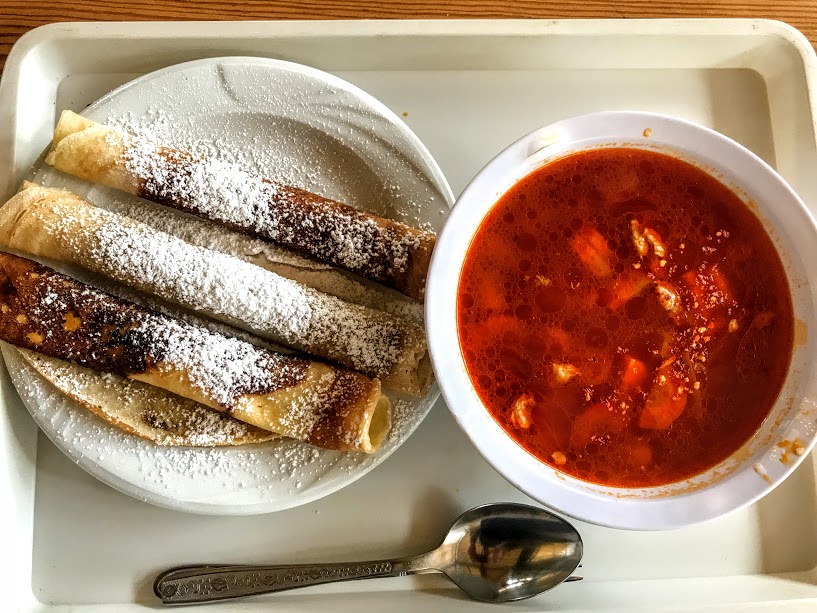
Hungarian food 101
Hungarian food is a reflection of Hungary's continental climate (cold winters, hot summers), the countryside fare, and the influences of neighboring countries and ethnic minorities. For example, while Hungarians have been eating some form of goulash for hundreds of years, dishes like stuffed peppers, schnitzel, and cholent have gradually seeped into the mainstream thanks to Ottoman, Austrian, and Jewish influences, respectively.
The culinary high point of medieval Hungary was the 15th-century reign of renaissance king Matthias. Through his Naples-born wife, Beatrice, Matthias hired skilled foreign chefs who whipped up elaborate feasts in the royal palace that could rival those in Italy at the time.
While the occupation by Ottoman Turkey ended Hungary's independence for nearly two centuries, it also brought forth important culinary innovations — stuffed vegetables, some dessert dishes, and coffee appeared in this time. This was also when New World produces like beans, squash, corn, potato, tomato, and paprika first arrived in Hungary. In fact, paprika (capsicum) went on to revolutionize Hungarian food after local farmers cultivated a host of subspecies ranging from sweet to scorching hot.
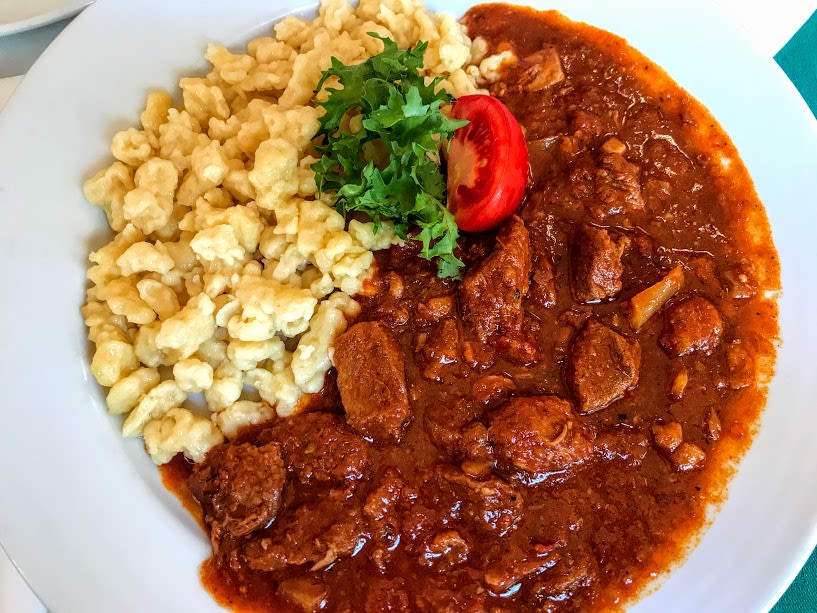
Meanwhile, the delicate French cooking techniques began to spread into the households of the aristocracy and later the whole country, taming the somewhat crude and spicy Hungarian peasant fare (for example roux replaced bread as a thickener). This yielded a more refined yet still distinct cooking style that's considered the basis of modern Hungarian food.
Given the small size of Hungary, regional differences are scant. One notable exception is Transylvania, part of Romania today but with a sizable Hungarian community. There, instead of paprika, herbs and spices like ginger, tarragon, thyme, rosemary, summer savory, and juniper have remained essential seasonings. Transylvania is also known for its corn-based dishes like polenta and sheep's milk cheese.
Lunch in Hungary usually begins with a soup. Unike in many Eastern European countries, few soups have a characteristically sour taste. At the top of the soup hierarchy sits the flavorful húsleves, literally meat soup, usually made from long-simmered beef or poultry. No wedding reception is complete without it. The everyday soup of choice is usually determined by the season: There might be a hearty bean soup studded with smoked ham hock (Jókai bableves) in the cold months, and a light fruit soup in the summer.
Hungary's climate is suitable to cool and warm-season vegetable crops alike, so there's both things like carrots, beets, kohlrabi, cabbage, cauliflower, but also tomatoes, bell peppers, green beans, and summer squash. Rather than reducing them to boiled or steamed side dishes, seasonal vegetable stews thickened with sour cream (főzelék) often appear as a main course. Before vegetables became available year-round, most people got their vitamins and carbs in the form of sauerkraut and potatoes in the cold months.
The concept of a salad course doesn't exist in Hungary. Instead, people accompany their main course by a small plate of seasoned vegetables, usually shredded cabbage, cucumbers, beets, or tomatoes. This is also the case during the winter, when they eat them pickled (savanyúság).
Meat is fundamental to Hungarian food. The options span poultry, beef, and to a lesser extent game and game birds, but pork is most prevalent. Pork turns up in myriad forms. A paprika-laced roast sausage paired with mustard and a slice of crusty bread is a popular everyday meal, but higher-end restaurants also serve roasted mangalica, the curly-haired breed of heritage pork known for its flavor-rich marbled meat. Historically, lard was the main cooking fat but it's now eclipsed by vegetable oils.
Before the use of refrigerators, the main source of protein in people's diets came from preserved meats which are still popular. Szalonna and kolbász are the two main categories, both of them traditionally made during the annual winter pig slaughter. The premium téliszalámi — a smoked, fermented, and aged sausage laced with herbs — is rightfully regarded as a national treasure.
Hungary is a landlocked country. This doesn't mean you can't find a decent grilled shrimp cocktail these days, but freshwater fish like carp (ponty), catfish (harcsa), and, less commonly, trout (pisztráng) and pike-perch (fogas), are likely fresher. Sadly, long gone are the days when beluga sturgeons swarmed in the Danube. And while fish isn't the strongest suit of Hungarian food, the local fish soup — fisherman's broth or halászlé — is worth trying.
For centuries, noodles have been central to Hungarian food. People would eat them on days of fasting, several times a week. They appear in many soups, but more interestingly, there's a whole category of sweet (!) pasta dishes: regular noodles coated in ground poppy seeds (mákos tészta), ground walnuts (diós tészta), or toasted semolina (grízes tészta) and powdered sugar. People usually eat them as a second course after a hefty soup.
Also notable are the countless dessert dishes that originated in Austria-Hungary and are still widespread across the successor states. Examples include the kaiserschmarrn (császármorzsa), the jam-filled potato dumplings (szilvás gombóc), the poppy seeds bread pudding (mákos guba), and the sugary yeast rolls (aranygaluska). As with sweet pastas, they're served warm and usually eaten in place of a main course. The most common dessert in Hungary is palacsinta, a crepe-like unyeasted pancake rolled with fruit jam, túró, or cinnamon sugar.
Like Austria, Hungary is a cake-superpower. Many of the traditional cakes feature ground poppy seeds, ground walnuts, and chestnut paste, sometimes entirely replacing wheat flour. Note that restaurants in Hungary don't serve cakes; instead you'll have to visit a specialized pastry shop (cukrászda) to try a classic Dobos or Esterházy torte.
Hungarian cheeses don't exactly set the world on fire, in part because unlike in France and Switzerland, there's little available mountain pasture in the country for cows to graze on (Hungary's per capita milk consumption is also one of the lowest in the EU). But sour cream (tejföl) appears in many foods. With a hint of tartness, it lends a pleasant kick and a creamy consistency to dishes. Also popular is túró, a snow-white, fresh, unripened curd cheese similar to cottage cheese. Túró is highly versatile, appearing in both sweet (túrós batyu) and savory (túrós csusza) classics, and also in Hungary's iconic candy bar, the Túró Rudi.
Historically, Hungary has been a wine-drinking rather than a beer-drinking country, with Tokaj in the northeast being the top wine region. The communist era (1947-1989) did no favors to the reputation of Hungarian wines, but today a new generation of ambitious winemakers are committed to putting the country back on the radar of oenophiles.
The 85 Essential Hungarian Dishes
Dear reader, before you start questioning the origins of the below dishes, bear in mind that regional foods influence one another in all parts of the world. For example, the goulash has become as much a standard in Austria as did the Wiener schnitzel in Hungary. If anything, this is a beautiful cultural exchange through food, enriching the cuisine of both countries.
In Budapest, you'll find many of the below dishes in traditional Hungarian restaurants, and also in étkezdes, which are cheap, unfussy, lunch-only restaurants. Note that some of the items are seasonal, such as the wintry cabbage rolls, so they may not be served year-round.
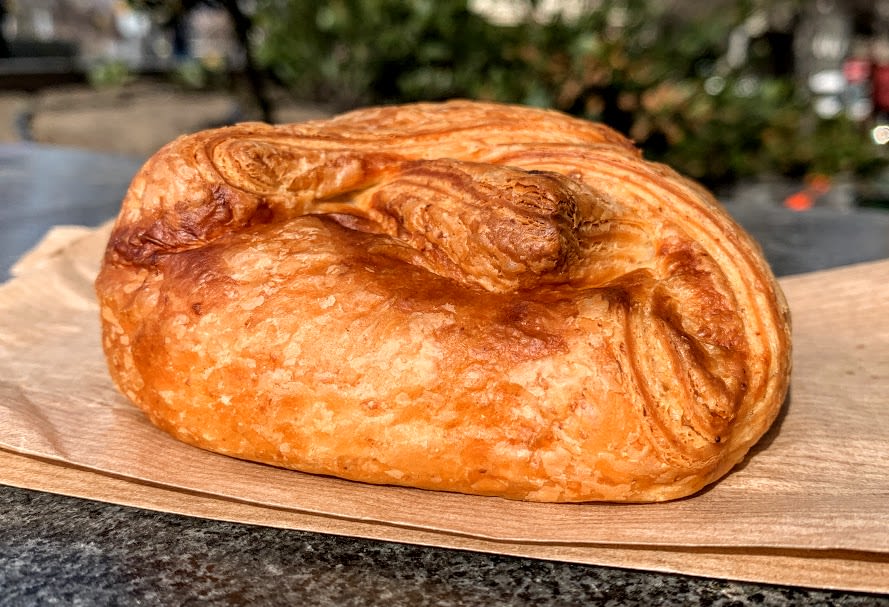
#1 - Túrós batyu: Like in Italy, France, and Scandinavia, many people in Hungary start their days with a morning pastry instead of a full breakfast dish. The stuffing of sugary túró, a snow-white fresh curd cheese, lends a beguiling sweet-tart flavor to this palm-sized breakfast snack, which is available in almost any bakery and which evolved from the medieval túrós béles. Back then, people ate it only on special occasions.

#2 - Chocolate bun (kakaós csiga): Apart from the túrós batyu, above, kakaós csiga is the other beloved morning pastry in Hungary. If you have a sweet tooth, you'll find this rich chocolate bun shaped in a spiral to be a real treat, especially if you eat it while still warm. My favorite in Budapest: Pékműhely Bartók.

#3 - Plum jam (szilvalekvár): Be it a simple topping to a toasted bread, a rich garnish to foie gras, or a filling of palacsinta, fruit preserves appear in countless Hungarian dishes. The varieties are endless — peach, raspberry, strawberry, sour cherry, etc. — but it's the plum jam (szilvalekvár) that goes back furthest. Before sugar became cheap and widespread in the 19th century, people made szilvalekvár without it, laboriously stirring the bits of fruit for 12-14 hours into a gel over fire.
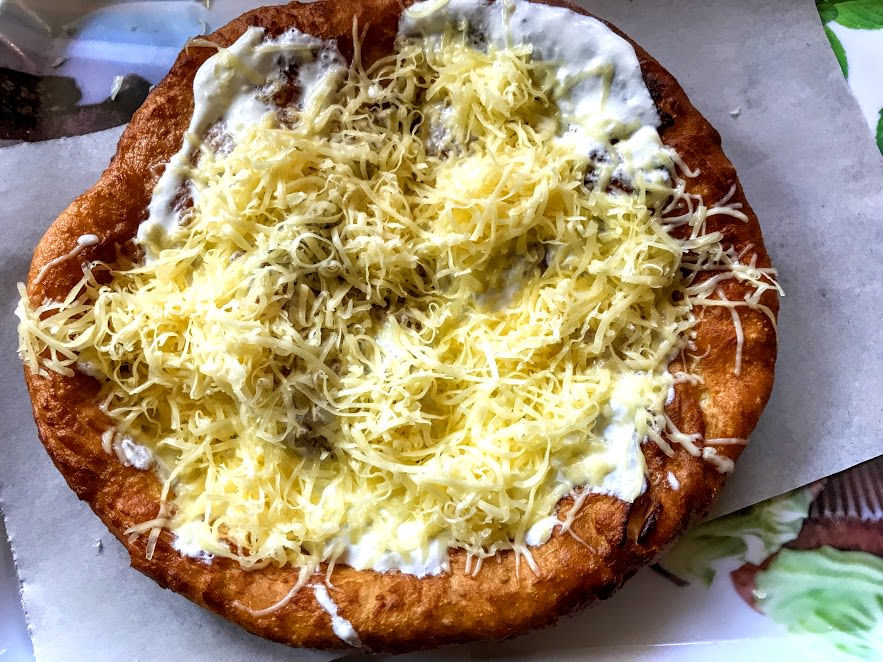
#4 - Lángos: Many Hungarians associate this disc of deep-fried bread dough with summer vacations spent at Lake Balaton, but thankfully lángos is available year-round. At its best, the crispy, golden crust yields to a soft and steaming inside (historically, lángos was a byproduct of bread baking at home). For the most memorable experience, try one rubbed with garlic and topped with sour cream and grated cheese.
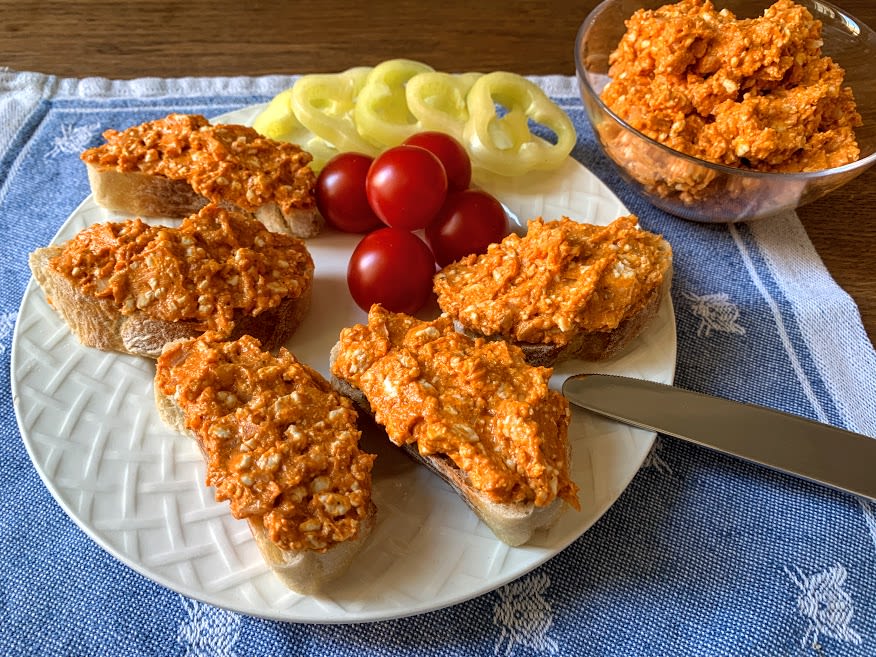
#5 - Liptauer (körözött): Named after the curd cheese of Liptov, in today's Slovakia, Liptauer is an orange-hued spread favored by people across the former Austro Hungarian Empire. While many variations exist, the mixture almost always includes sheep's milk curd cheese (juhtúró), butter, paprika, minced onions, and caraway seeds. If in doubt, cold lager is always a good companion to körözött-slathered sourdough. Recipe.
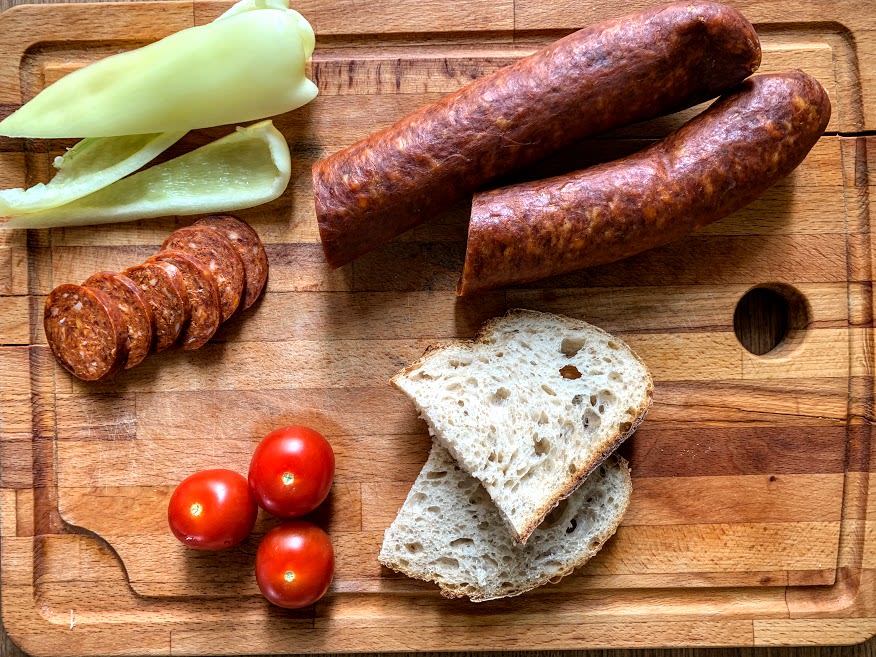
#6 - Cured sausage (kolbász): Cured meats are dear to the hearts of Hungarian people and perhaps none more so than kolbász, which they traditionally prepared during the winter pig slaughter. Kolbász consists of a paste of meat, fat, and a paprika-heavy spice blend. The mixture is stuffed into a tubular casing — usually using the pig’s intestine — and then smoked and dried. Sliced kolbász is highly versatile, appearing in many Hungarian classics, for example layered potatoes (rakott krumpli), and also as sandwich toppings. My favorite in Budapest: Most butcher shops in the Great Market Hall sell it. Feel free to ask for a sample first.

#7 - Szalámi: Traditional salami is a relatively recent type of preserved sausage in Hungary, dating back to the 19th century. Compared to kolbász, above, szalámi is thicker, aged longer, and usually made without paprika, hence the absence of an orange-red hue to it. A premium category is téliszalámi, recognizable by a white protective mold that grows on its surface during drying. Two historic companies, Pick and Herz, are still the main producers. Sliced szalámi works both as a snack and as a sandwich topping. My favorite in Budapest: Most higher-end grocery stores sell it.

#8 - Szalonna: “Szalonna” is an umbrella term for all cuts of preserved pork that come from right under the animal’s skin, be it fatback, pork belly, or jawl. Most szalonna is salted and smoked, but treatments vary by region. To this day, szalonna is a cherished, energy-rich sustenance across Hungary; people either cook it into dishes for a flavor boost or simply eat it as is with a slice of bread and vegetables. My favorite in Budapest: Most butcher shops in the Great Market Hall sell it. Feel free to ask for a sample first.
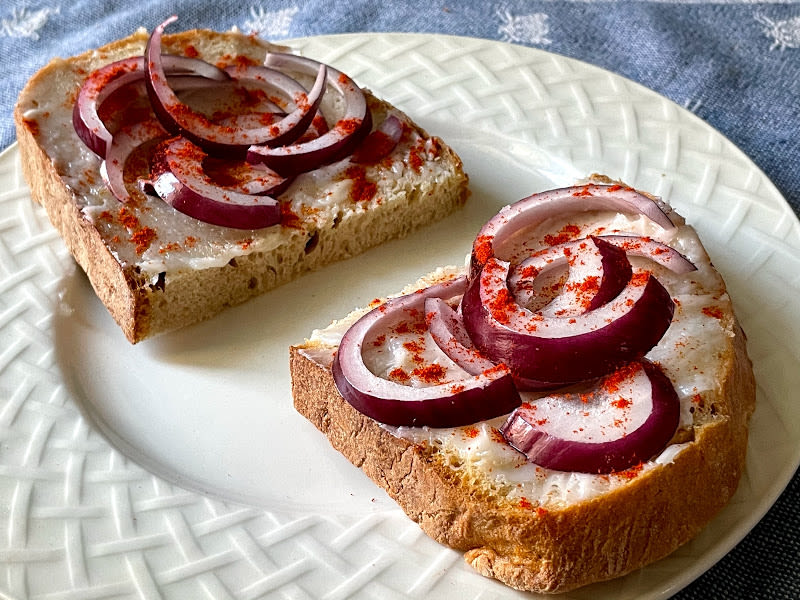
#9 - Bread spread with lard (zsíroskenyér): The tradition of spreading flavorful fat on crusty bread is alive and well in Hungary, too. While northern Europe has buttered toast, in Hungary creamy pork fat (lard) is the usual topping of choice. Sprinkled with rings of onion and a hint of paprika, the zsíroskenyér is a popular bar snack as it pairs well with draft beer and is also wallet-friendly. A few places also serve a VIP version made with Mangalica lard. My favorite in Budapest: Grinzingi, an old-school, unfussy neighborhood joint in downtown Budapest.

#10 - Fried fatback (töpörtyű & pörc): Morsels of fatback fried to a golden, crispy brown may not be for the faint of heart but they're delicious. Most butcher shops in Hungary make them from both pork and goose fat (schmaltz). Nibble at töpörtyű as they come or grab some red onions and a fresh slice of bread to pair. Pörc is a similar product, using pork belly instead of fatback (think chicharrón).
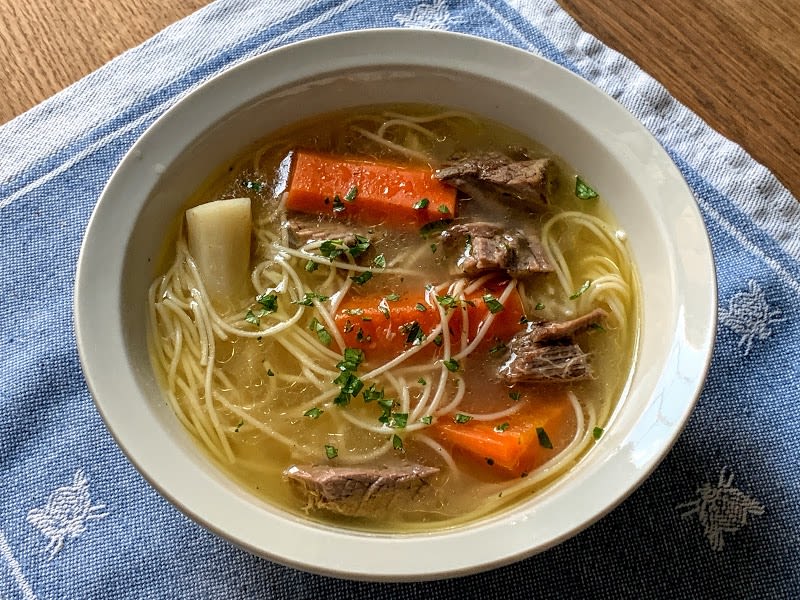
#11 - Beef consommé (marhahúsleves): Húsleves is a signature of Sunday family meals across Hungary, usually served from a large soup tureen for the whole table, similar to a pot-au-feu. The steaming, fragrant broth packs bits of tender beef, root vegetables, and noodles. It's often paired with bone marrow and toast on the side. Recipe.

#12 - Goulash soup: Once the nourishment of herdsmen, this quintessential Hungarian dish consists of a paprika-laced broth piled generously with cubes of tender beef, potatoes, and small noodles. The goulash soup is actually a 19th-century derivative of the goulash, made with more liquid and incorporating some vegetables. Confusingly, in Hungary, people refer to this soup as goulash, while the original goulash is known as pörkölt (see #41 below). Use the tableside hot paprika paste to adjust the spice level to your taste. Recipe.
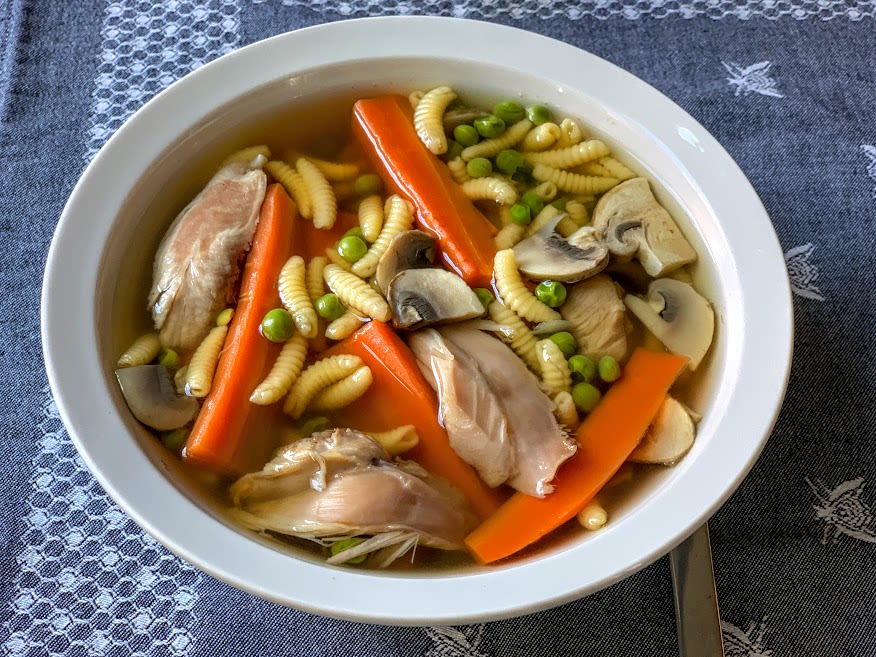
#13 - Újházi chicken soup: A classic of Hungarian wedding receptions, the Újházi is a flavor-rich chicken soup stacked with a mountain of vegetables — most of all: carrots, green peas, and mushrooms — and noodles. This reviving soup traces its moniker to Ede Újházi, a 19th-century Hungarian actor and a Rabelaisian figure who had the kitchen staff of Wampetics restaurant (the predecessor of the renowned Gundel) make it for him. The original recipe used capon instead of chicken. Recipe.
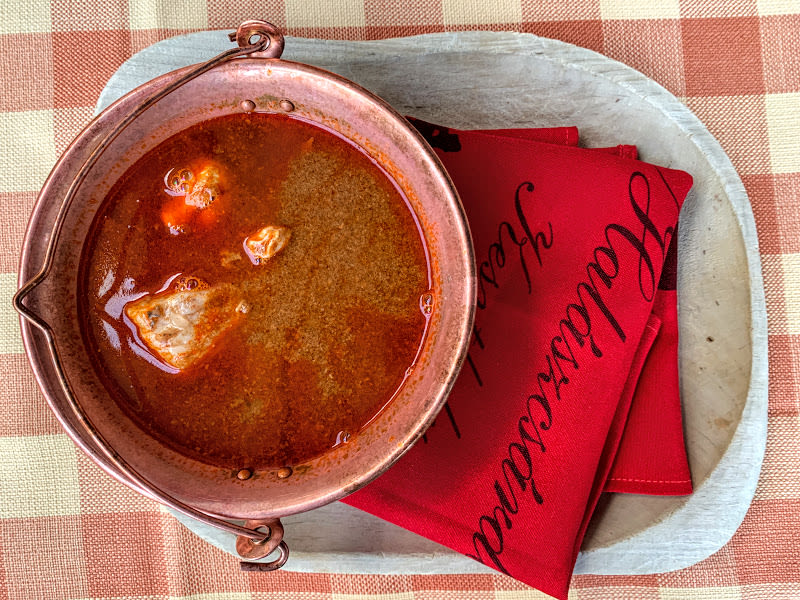
#14 - Fisherman's soup (halászlé): Hungary's take on the bouillabaisse has myriad regional permutations, most notably the fish soups originating in the riverfront cities of Baja and Szeged. Paprika and a range of small fish bolster the crimson-hued broth, which is anchored by tender carp or catfish fillets. Traditionally, halászlé is part of the Christmas-Eve dinner in Hungarian families.
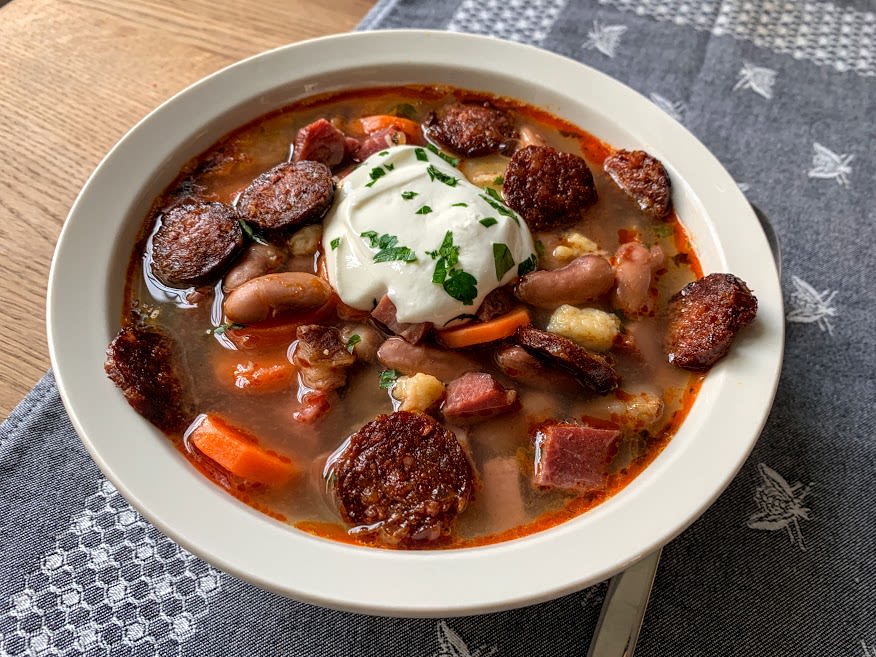
#15 - Jókai bean soup (Jókai bableves): This wonderfully bold winter soup is named after the beloved Hungarian writer, Mór Jókai, who was very fond of it. The main components are smoked pork, crispy sausages, pinto beans, some root vegetables, and small egg noodles (csipetke). As so many soups in Hungary, it’s usually finished with a dollop of sour cream. Words of advice: your most productive hours will not commence after polishing off a bowl of this one. Recipe.
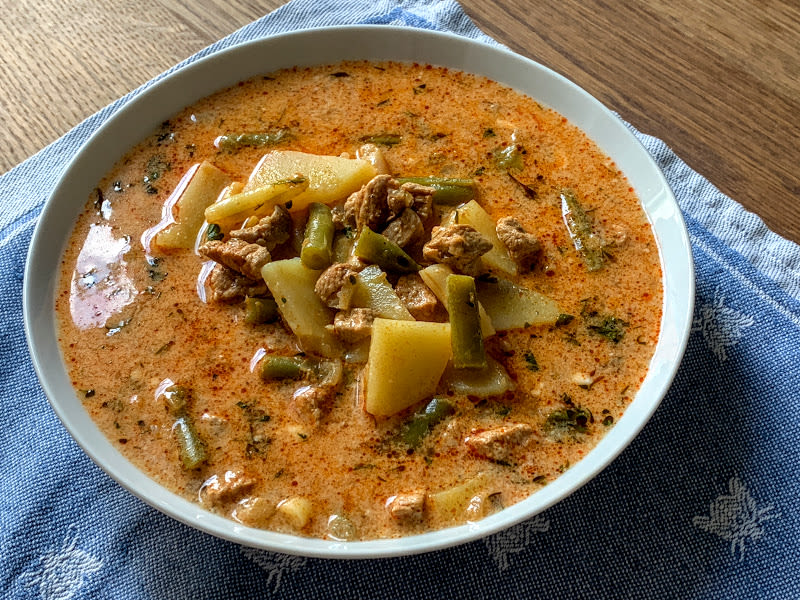
#16 - Palóc soup: This bright-tasting green beans soup is the creation of restaurateur János Gundel, father of the famous Károly Gundel. He made the soup in 1892 as a birthday present to Kálmán Mikszáth, his regular patron and a celebrated novelist and politician. Mikszáth wrote about the Palóc people in northeast Hungary, hence the soup's moniker. The original recipe calls for mutton, but most people make it with pork or beef these days. Recipe.
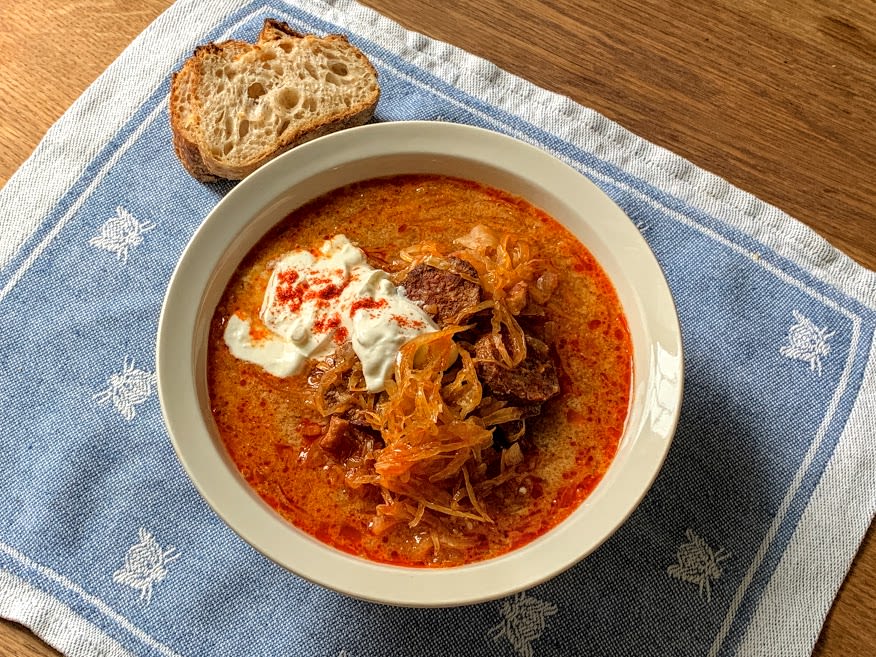
#17 - Sauerkraut soup (korhelyleves): Hungarians traditionally eat this winter soup as a hangover cure following a nocturnal debauch. Bright-tasting sauerkraut, crispy sausages, and a flavorful broth laden with sour cream are meant to soothe the stomach and mitigate the headache. Recipe.
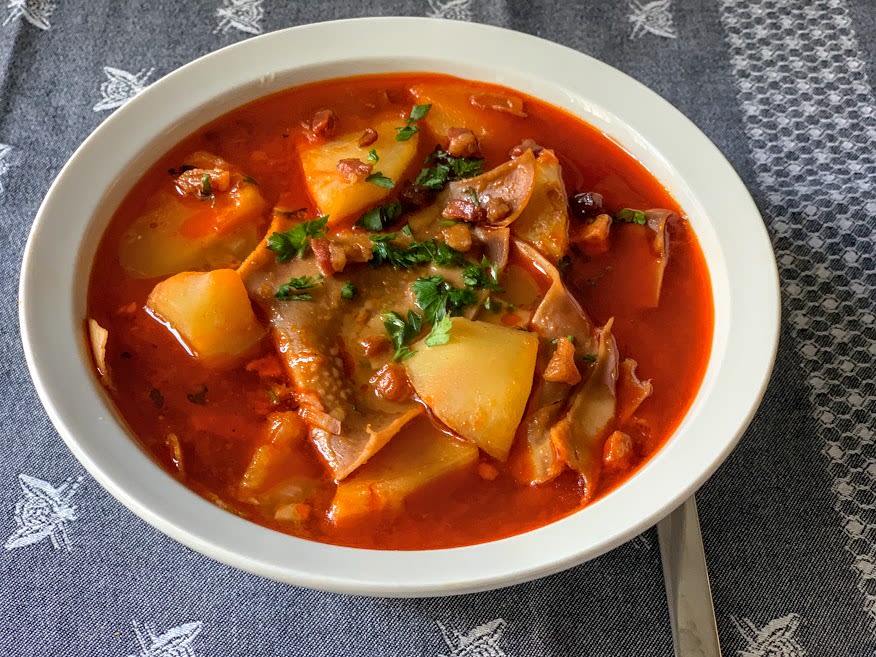
#18 - Lebbencs soup: This centuries-old noodle soup harks back to the countryside folks of eastern Hungary in and around the town of Debrecen. Lebbencs refers to huge sheets of paper-thin dough they'd roll and then dry in the pantry. As needed for the daily cooking, they’d chip off bits from it. The foundation of this simple but rewarding soup is rendered szalonna in which the lebbencs is lightly roasted. Recipe.
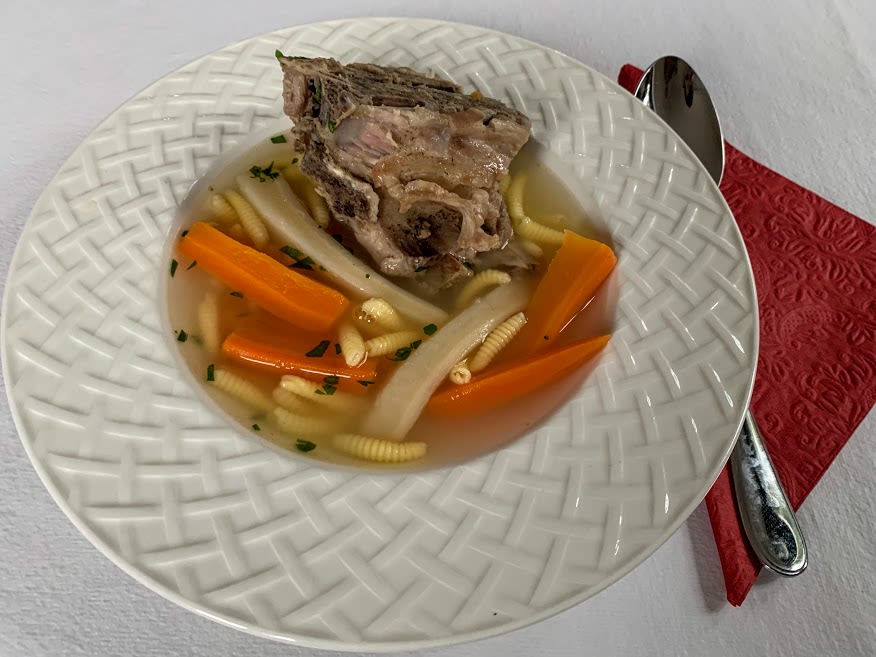
#19 - Pork bone soup (orjaleves): This dish dates back to the annual pig slaughter festivities in the Hungarian countryside where lunch would begin with orjaleves. But there’s good reason to whip up this stupendous bone soup even if you’re a city dweller. Part of the enjoyment is locating and savoring the tender bits of hidden meat left attached to the pork neck bone (feel free to attack it with your hands).
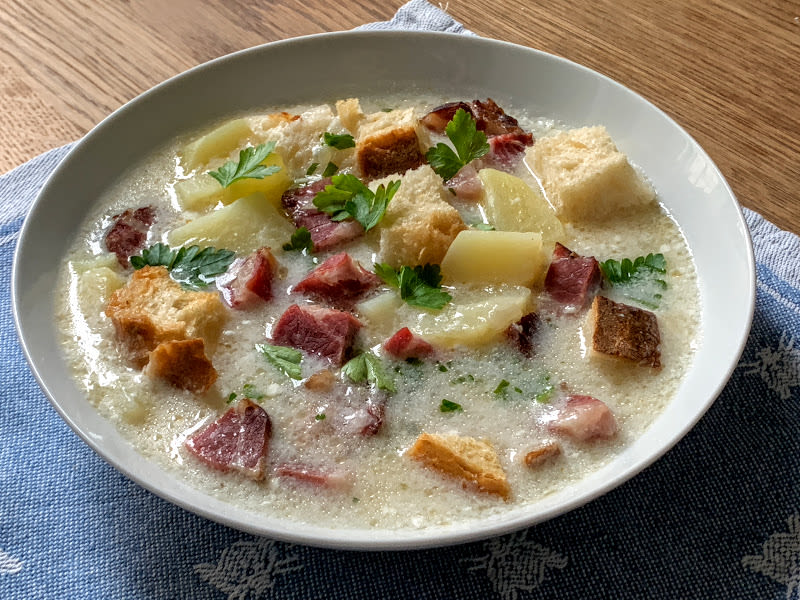
#20 - Kaszáslé: One of the oldest and now nearly forgotten soups in Hungary. It was named after the farm laborers who harvested wheat by hand using a scythe, a highly demanding physical task. The peasants would eat it during their lunch break in the summer heat under the cool shelter of a tree. It became a well-known soup across the country by the 16th century and, oddly enough, the aristocracy was as fond of it as the lower classes. There were many kaszáslé variations — some thickened with egg yolks, others with sour cream or roux — but the two key features of the soup are the smoked meat pieces and the slightly sour, bright-tasting liquid, which helped preserve it for several days. Recipe.
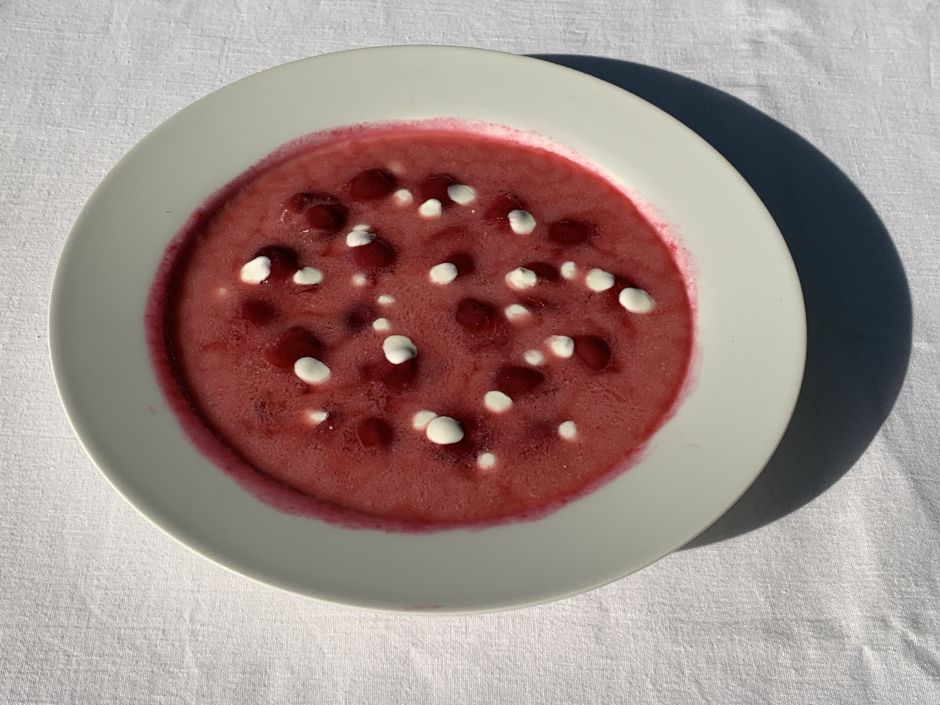
#21 - Chilled sour-cherry soup (hideg meggyleves): You’re unlikely to find this beloved summer treat outside of Hungary. The key is fresh, pitted sour cherries that are transformed — using water, spices, light cream, and sugar — into a deliciously silky, sweet-tart chilled soup. Recipe.
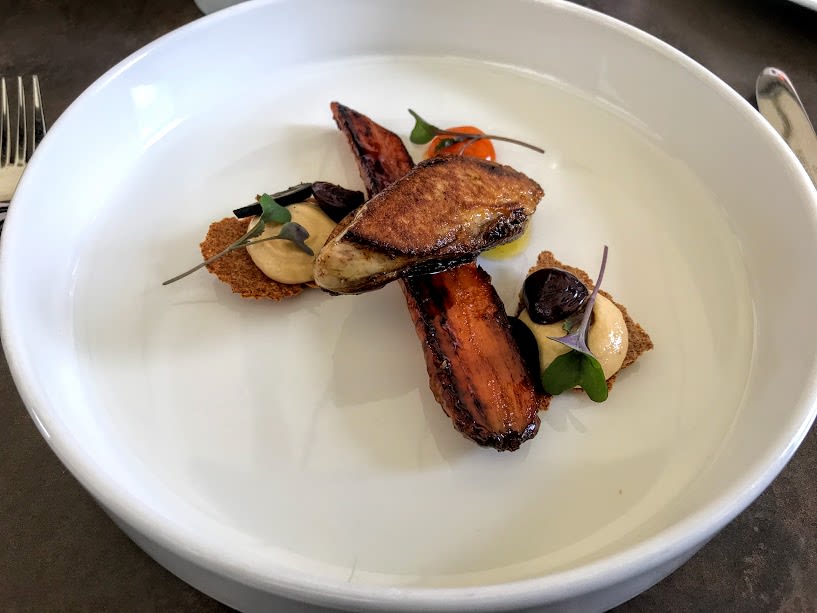
#22 - Foie gras (libamáj): Usually associated with French fare, few people know that Hungary is the world's second biggest producer of foie gras. Most fine dining restaurants serve this delicacy as an appetizer with a side of fruit jam to match the rich flavor and buttery texture of the fattened duck liver (traditionally, foie gras pairs with a glass of golden Tokaji aszú wine). Though not cheap, foie gras in Budapest is more affordable than in most places around the world.
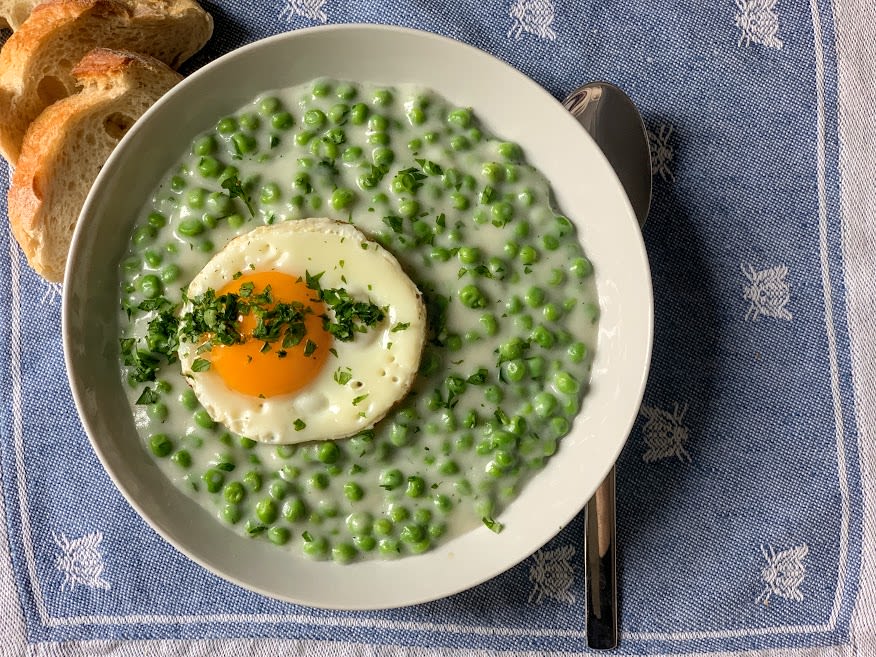
#23 - Green pea stew (zöldborsó főzelék): Be it potato, kohlrabi, cabbage, spinach, lentil, beans, green peas, or squash, Hungary’s love affair with vegetable stews (főzelék) is seemingly endless. Főzelék can stand on its own as a main course paired simply with a thick slice of crusty bread — historically eaten on days of abstinence — but toppings often include a sunny-side up egg, a meatball, pörkölt, or sausage. Recipe.
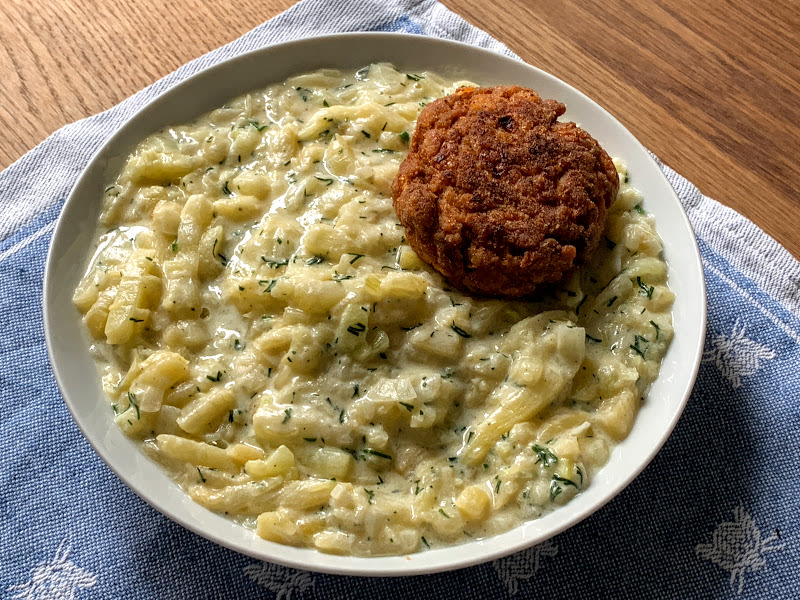
#24 - Summer squash stew (tökfőzelék): One of Hungary’s most commonly eaten vegetable stews draws both avid admirers and staunch detractors. Thickened with sour cream, spiked with fresh dill, and topped with a meatball, the tökfőzelék is a reviving summer dish (some people serve it chilled). Recipe.
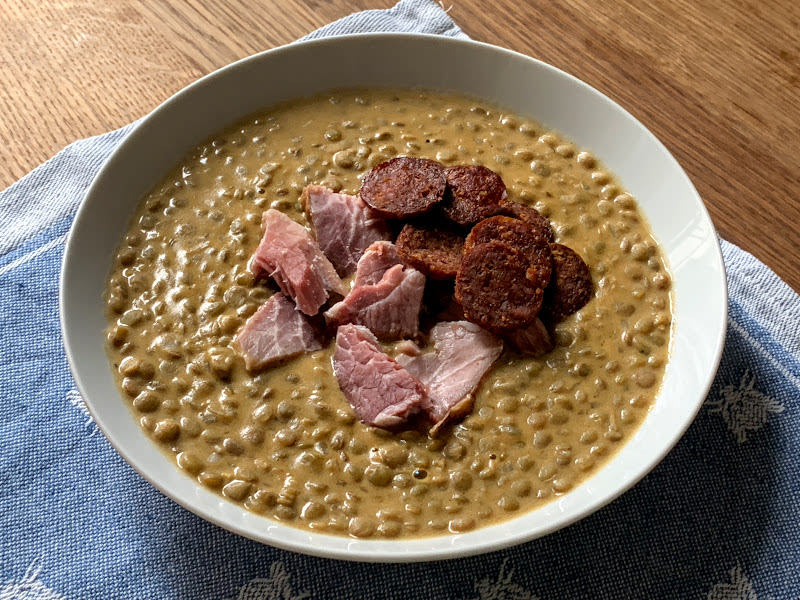
#25 - Lentil stew (lencsefőzelék): As in some other cultures, the myriad lentil seeds symbolize prosperity and hence this dish is a must-have on New Year's Day across Hungary. Sour cream, mustard, and a bay-leaves-forward spice mix concentrates the flavors of this vegetable stew, which is often topped with smoked meat. Recipe.
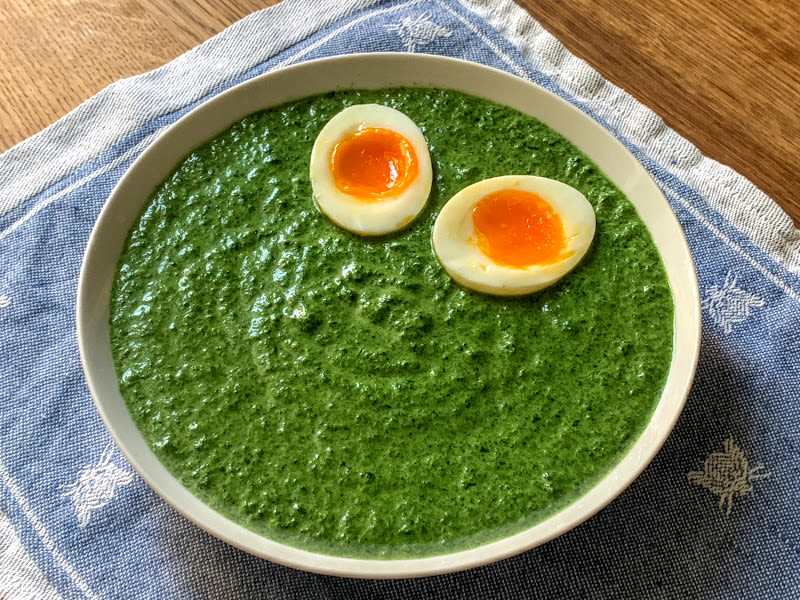
#26 - Spinach stew (spenótfőzelék): Light cream, a hint of garlic, and whipped egg yolks help round out this delicious and smooth spinach stew. It pays off to make it with mature spinach, which has more flavor than the mild baby spinach. Fried, soft-boiled, or poached eggs usually go on top. Recipe.
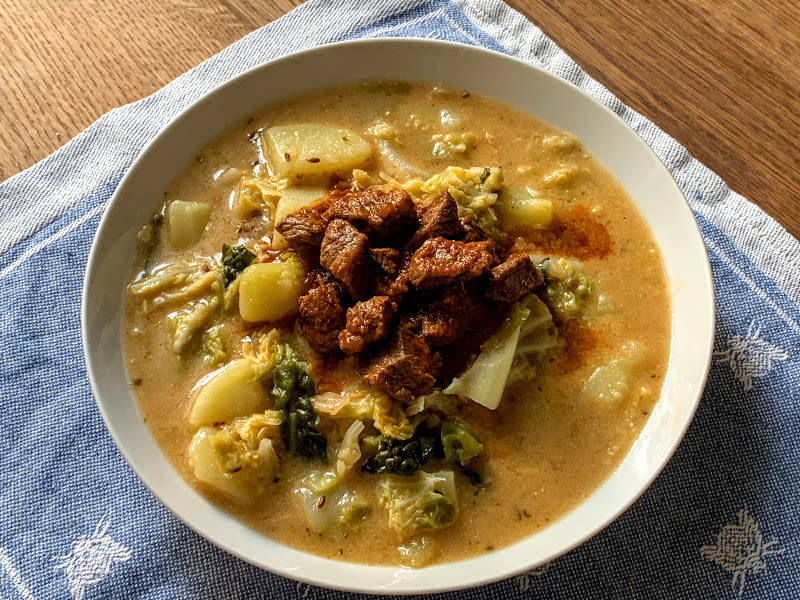
#27 - Savoy cabbage stew (kelkáposzta-főzelék): Bits of crinkly Savoy cabbage and potato chunks crowd this creamy and mild vegetable stew flavored with caraway seeds. Using tender new potatos and a few tablespoons of sour cream to finish turn this everyday dish into a luscious treat. Recipe.
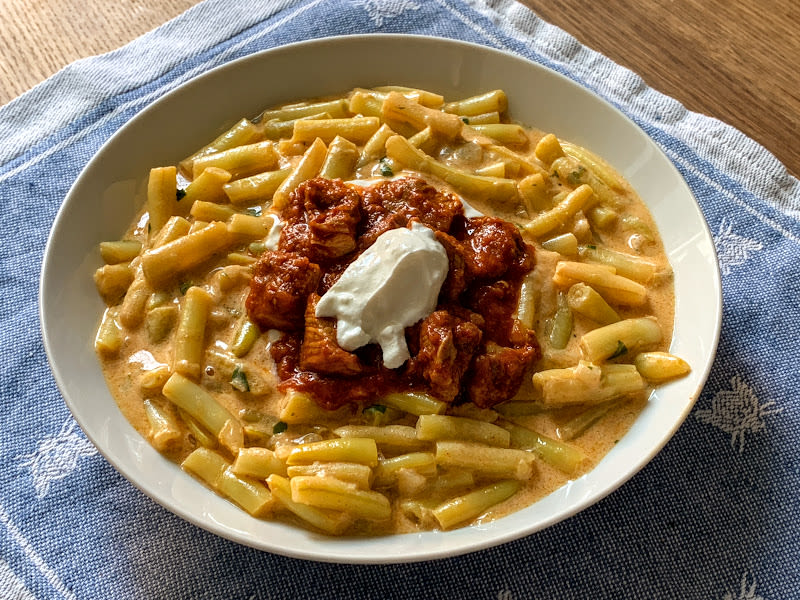
#28 - Green beans stew (zöldbabfőzelék): Green and yellow wax beans stew have been popular for a long time in Hungary. A generous amount of sour cream and a bit of lemon juice (or vinegar) impart the signature bright flavor to this summer dish, which is often served cold during the warmest months. Recipe.

#29 - Tomato cabbage stew (paradicsomos káposzta): No summary of Hungarian food is complete without a cabbage stew; this one calls for fresh cabbage but also works with sauerkraut. The creamy tomato sauce lends a hint of tartness and an impressive red hue to this sweet-sour dish. Generally, a side of roasted pork ribs is served on top. Recipe.
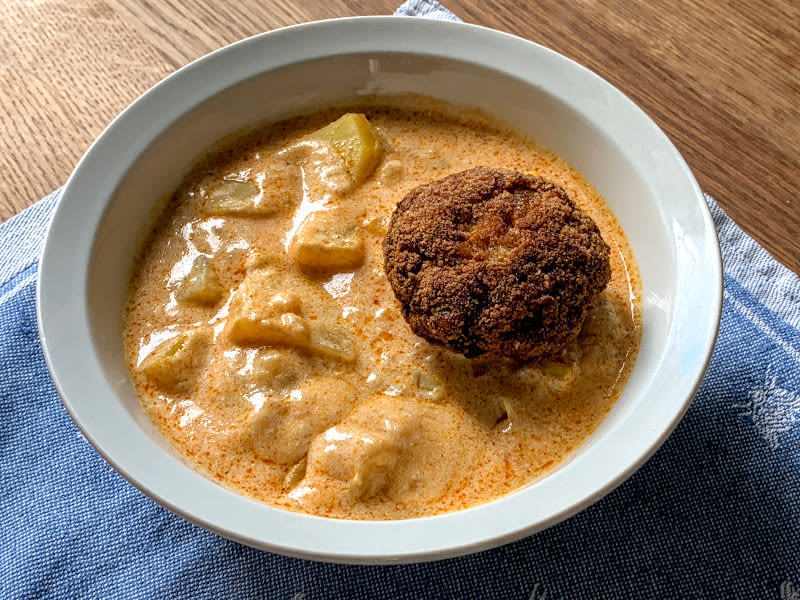
#30 - Potato stew (krumplifőzelék): By the early 19th century, potatoes, which came from the Americas, spread all across Hungary. They were an economical alternative to cereal crops and hence appeared in ever more dishes — in soups, porridges, and noodles. Perhaps none became more prevalent than the potato stew, sitting in a creamy, bright-tasting sauce and usually topped with meatballs. Recipe.
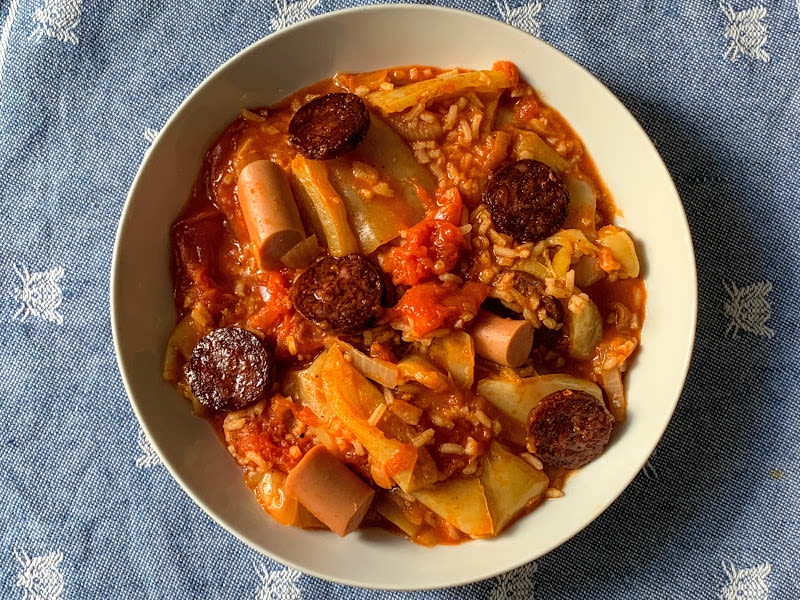
#31 - Lecsó: Made from wax peppers, tomatoes, and onions, the best time for this Hungarian ratatouille is the late summer when these vegetables are ripest and most flavorful. Lecsó is even better when boosted with rice or fried eggs and thin slices of crispy sausage. Recipe.
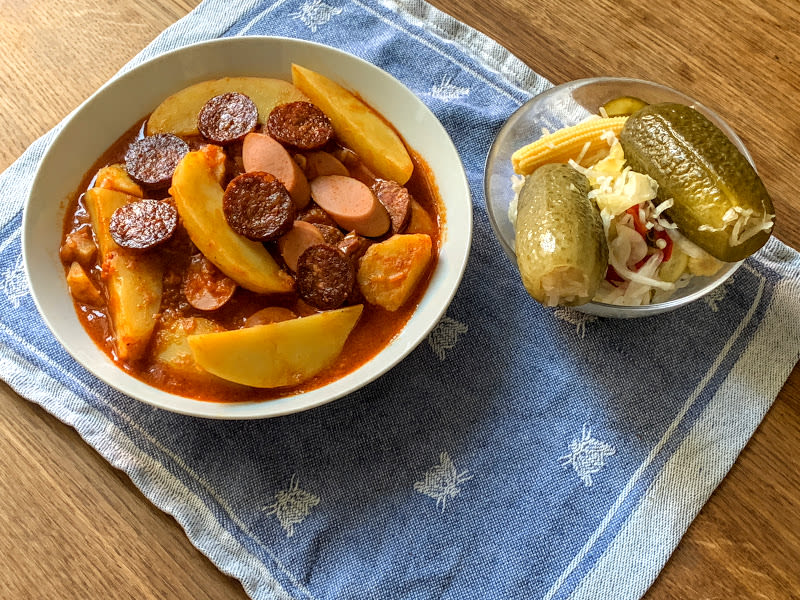
#32 - Paprika potatoes (paprikás krumpli): While some consider it to be low-brow, don’t look down your nose at this bold potato dish that has nourished generations of Hungarians. The simple ingredients belie the nicely layered flavors owing to the szalonna, the paprika sausages, and the sliced frankfurters. Recipe.
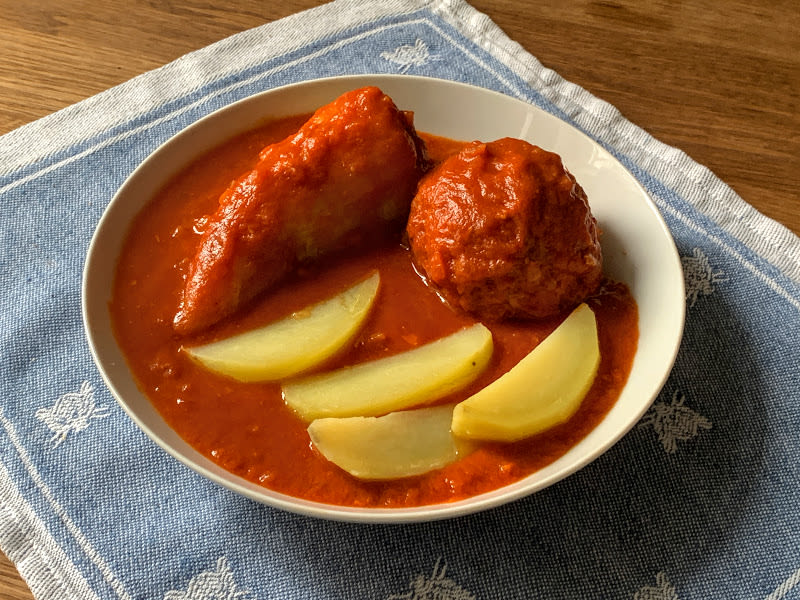
#33 - Stuffed peppers (töltött paprika): As with the stuffed cabbage, below, the origin of stuffed peppers dates back to the Ottoman era in Hungary. Since then, the dish has become a local favorite across the country. The peppers are filled with a mixture of ground pork, rice, sauteed onions, and a flavorful mixture of herbs and spices. They’re served on a bed of subtly sweet tomato sauce with a side of boiled potatoes. Recipe.

#34 - Stuffed cabbage (töltött káposzta): In medieval Hungary, meat with a side of sauerkraut was a national dish. During the Ottoman occupation, the Turkish practice of stuffing meat into vegetable leaves was adopted, and hence the cabbage rolls appeared. A bed of sauerkraut and a generous dollop of sour cream topping set apart the local version from the regional varieties. Töltött káposzta is a treasured winter staple and an obligatory course at Hungarian wedding receptions. Word to the wise: it tastes even better the next day (and the day after that). Recipe.
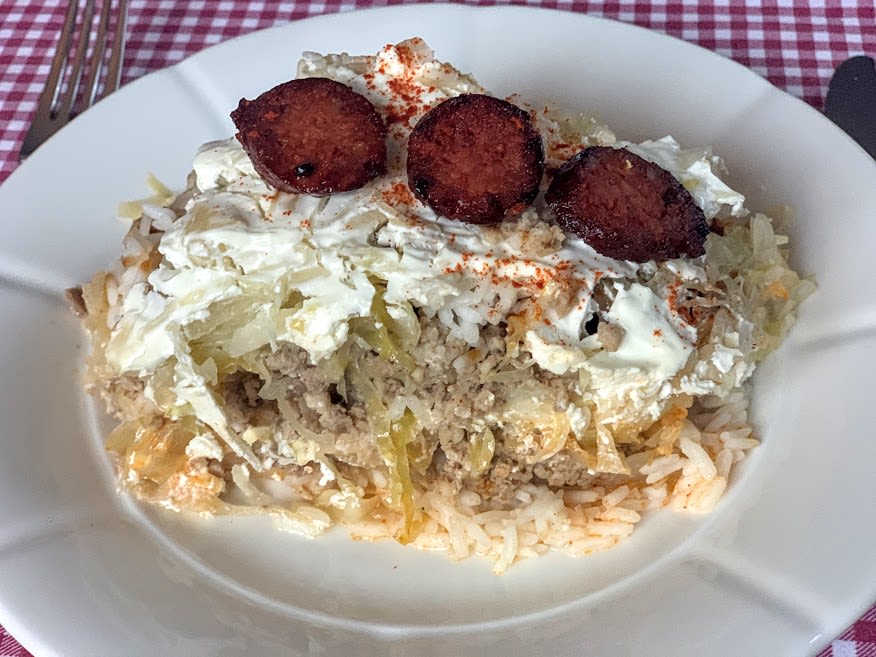
#35 - Layered cabbage (kolozsvári rakott káposzta): This hearty cabbage dish is designed to enliven the gloomy winter evenings. The ingredients have evolved over the decades but the foundation consists of sauerkraut layered with rice, smoked sausages, and sour cream; gluttons should consider adding slices of hard-boiled eggs and szalonna. It's one of those foods that tastes even better when reheated the next day.
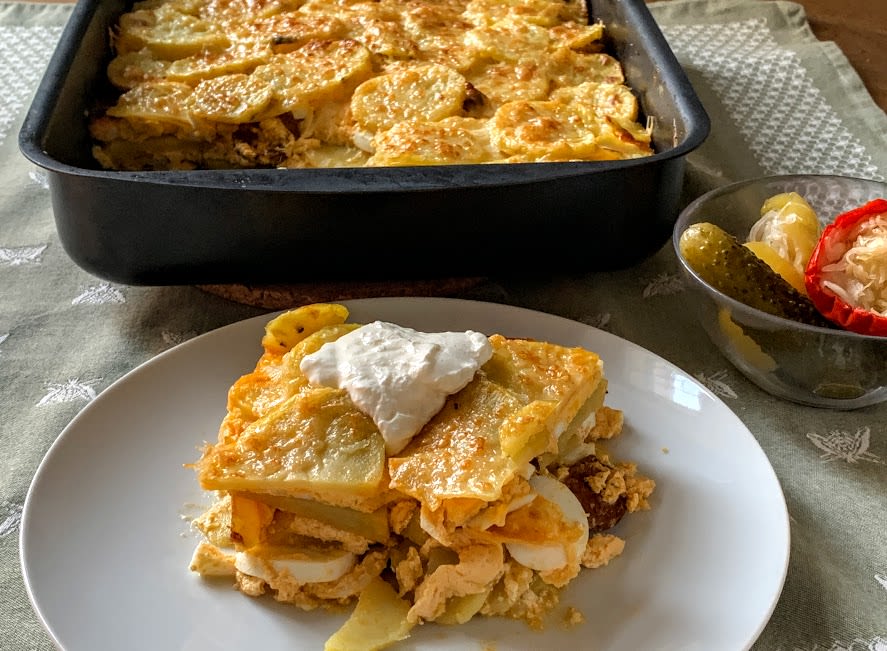
#36 - Layered potatoes (rakott krumpli): Hungary's take on the potato gratin, which is eaten as a main dish here, features rings of hard-boiled eggs, bolstered sour cream, and crisped-up paprika sausages. The sum of the parts is light and creamy and delicious. And also refreshing when served with a side of pickled vegetables. Recipe.
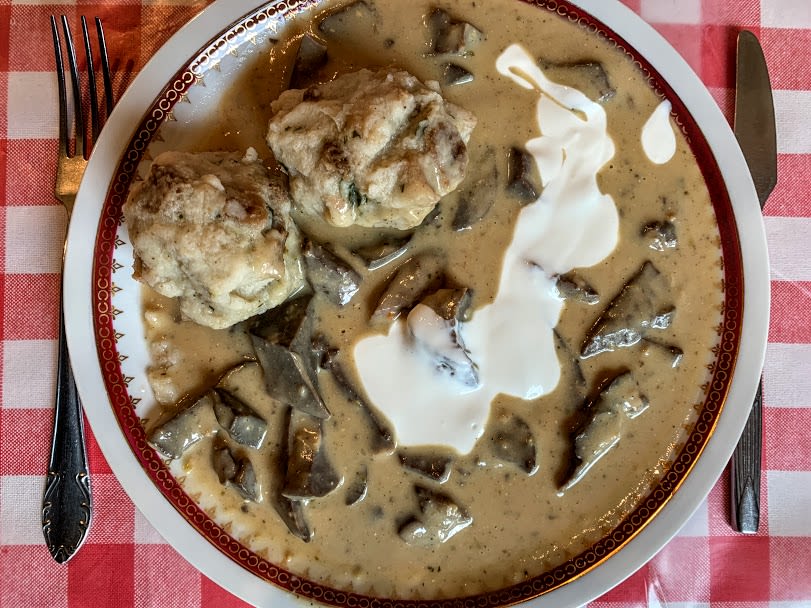
#37 - Lungs with bread dumplings (szalontüdő / savanyútüdő): Also popular in the Czech Republic and Austria, this plate of cooked veal lungs — the traditional recipe calls for veal but in Budapest it’s often made with beef or pork — is tastiest when served with a creamy and bright-tasting sauce tinged with lemon juice and a couple of bread dumplings on the side.
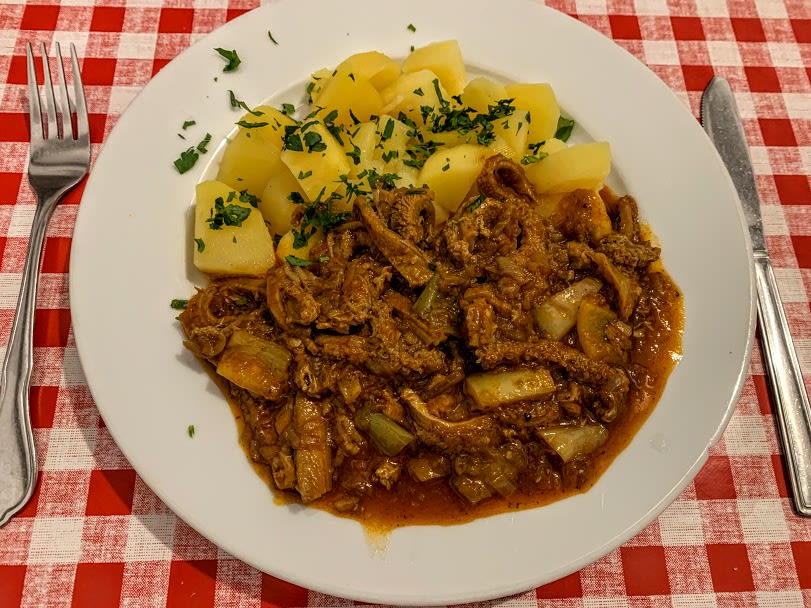
#38 - Hungarian tripe stew (pacal pörkölt): As in Italy and France, tripe in Hungary has long been considered a poor man’s food but it can be wonderfully delicious when cooked to tender submission with a bit of bite left to it. In Hungary, naturally, the julienned strips of beef tripe arrive in a red-hued paprika sauce and with a side of boiled potatoes.
#39 - Goose giblets porridge (ludaskása): One of Hungary's oldest dishes, although in the days of yore the ludaskása was often made with millet porridge instead of rice. It consists of leftover goose giblets and bits of goose back that are cooked into a bed of al dente rice mixed with root vegetables. Ludaskása is an economical dish that was highly popular among both the Christian and the Jewish residents of Budapest around the turn of the 20th century.

#40 - Roasted sausages (sütőkolbász & hurka): Be it breakfast, lunch, or dinner, roasted sausage is an adored comfort food in Hungary. A generous dollop of mustard, pickled vegetables, and a thick slice of crusty bread are all you need for this pretense-free meal. Kolbász is a meat sausage with paprika-forward spices while hurka is stuffed with a paste of cooked offal and rice. My favorite in Budapest: These sausage shops.
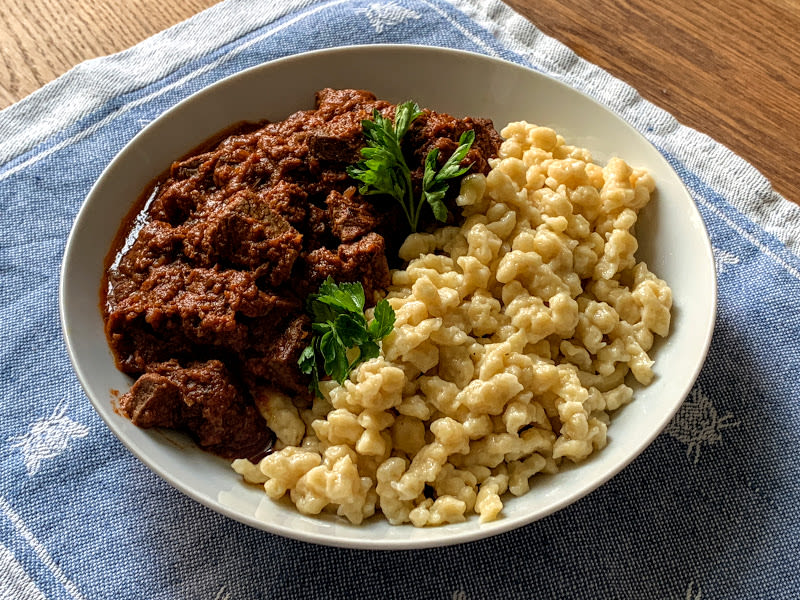
#41 - Goulash (pörkölt): Hungary's national dish originated among herdsmen — the goulash — who spent months on end tending to the cattle in the Hungarian Plain (Alföld), away from all signs of civilization. The gulyás would sprinkle szalonna (pork fat) and onions into large cast-iron kettles called bogrács and roast morsels of beef over fire. The addition of paprika appeared in the 18th century. The traditional side to both the goulash and its sister dish, the paprikash (see next entry), is egg dumplings (galuska) or egg "barley" (tarhonya). Recipe.
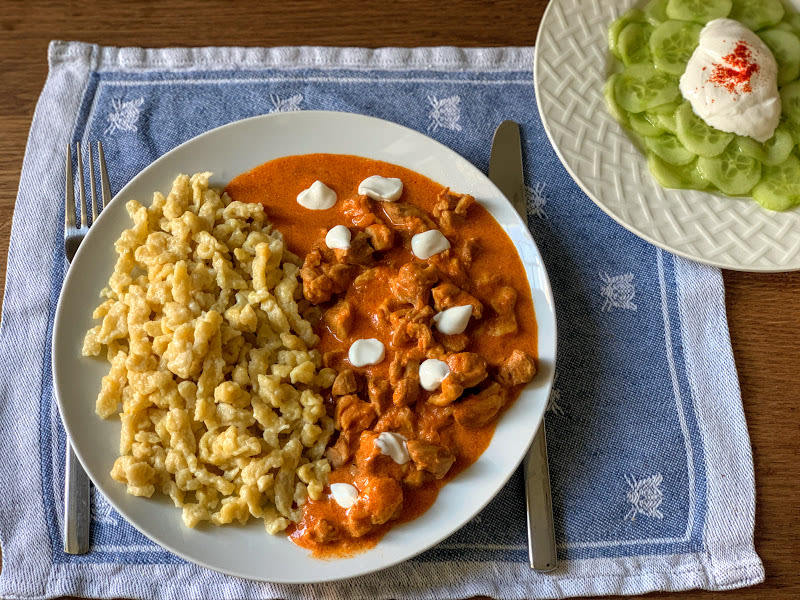
#42 - Chicken paprikash: For a long time, paprikash and goulash meant the same thing and were used interchangeably. Today, there’s a slight difference between these centuries-old Hungarian classics: the paprikash is usually made with chicken or veal and always finished with sour cream. Because of its lush, creamy sauce, many people favor the paprikash of the two. Recipe.
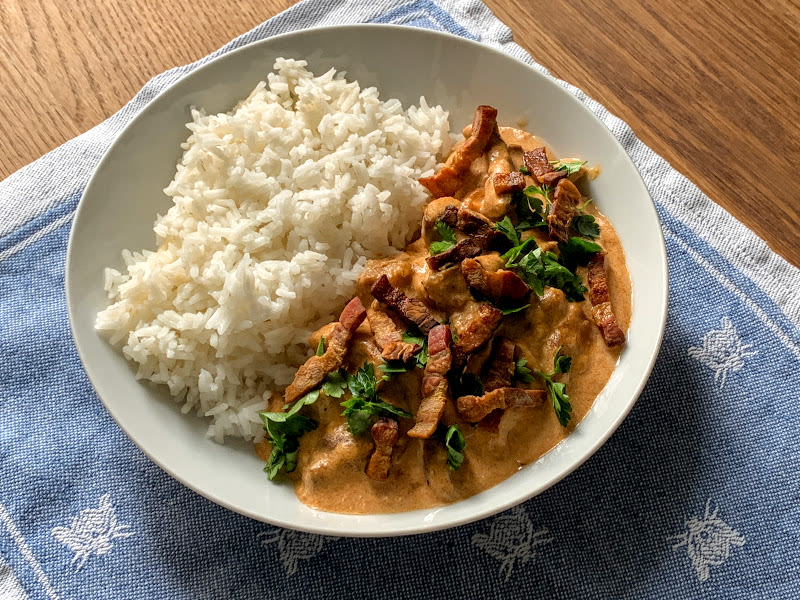
#43 - Csikós tokány: Tokány is a stew dish similar to the goulash and the paprikash, above, but usually prepared with less paprika than those two. Historically, tokány was common in Transylvania and the name itself comes from the Romanian word for ragout. You can recognize a tokány by the thin, elongated shape of the meat pieces. Smoked szalonna and sour cream give a distinct taste to the csikós tokány, which can be made with any meat you like. Recipe.
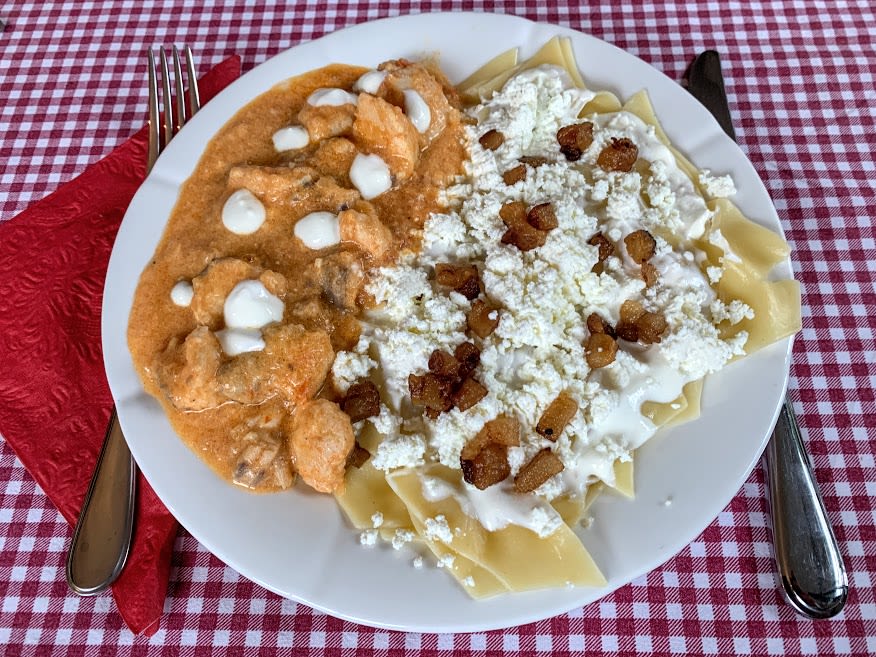
#44 - Catfish paprikash (harcsapaprikás): Like Hungarian shepherds, the local fishermen also fell for the beguiling pungency of paprika when this spice spread across the country in the 18th century; soon their fish-heavy dishes were suffused with the crimson shade of capsicum. Today, this fish stew is typically made with catfish and served with a side of túrós csusza (see below), ensuring a regret-inducing level of calorie intake.
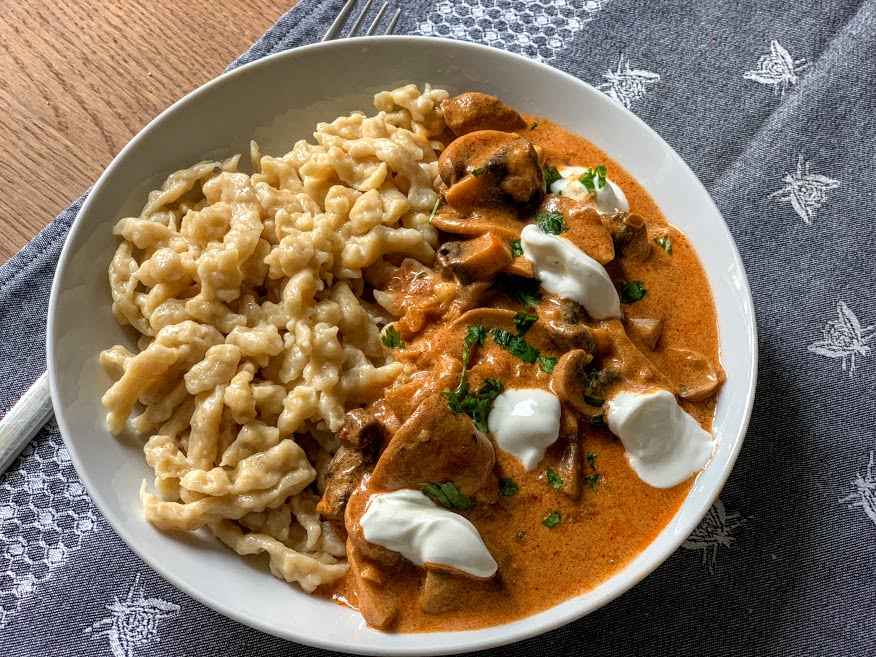
#45 - Mushroom paprikash (gombapaprikás): If you’re vegetarian or simply don’t feel like eating meat, this mushroom paprikash is a good foray into the world of paprika-spiked Hungarian classics. The dish works best with basic white or cremini mushrooms that don’t overwhelm the rich and creamy sauce. Egg dumplings (galuska) or rice are usually on the side. Recipe.
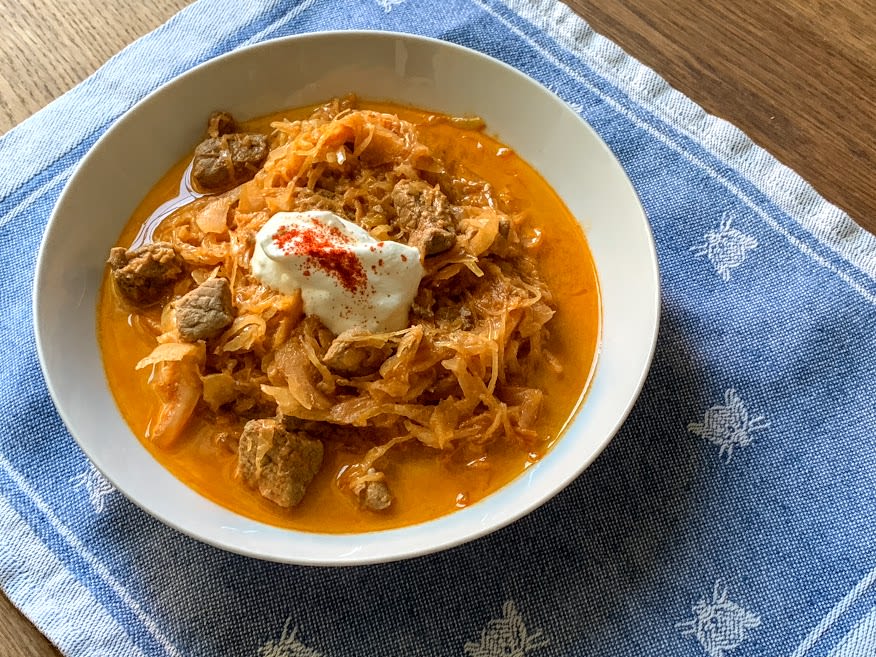
#46 - Sauerkraut goulash (székelykáposzta / székelygulyás): A Budapest restaurant invented this hefty dish in 1846 using leftover pork goulash (pörkölt) and sauerkraut. The mixture quickly became a hit and spread across Hungary. Despite what many people think, székelykáposzta has nothing to do with Transylvania; while székely people do live in Transylvania, the dish’s moniker actually refers to József Székely, the person who first ordered it. Recipe.

#47 - Pork rice pilaf (bácskai rizses hús): This dish comes from Hungary’s southern neighbor, Serbia, based on a casserole called djuvec. It’s essentially a rich rice pilaf studded with bits of stewed pork. Another way to think of it: toss your leftover pork goulash with rice. The bácskai rizses hús isn’t complete without a side of pickles and some recipes also call for a drizzle of grated cheese on top. Recipe.
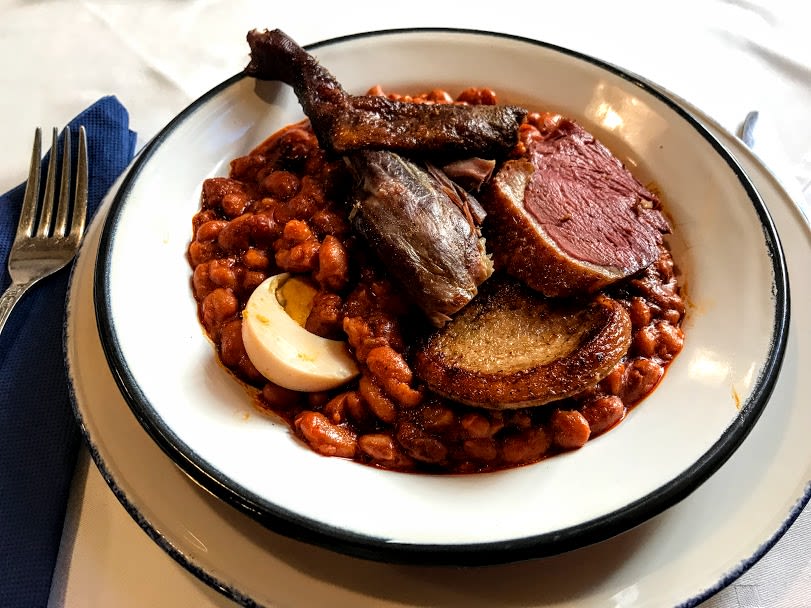
#48 - Cholent (sólet): First introduced in Hungary by the local Jewish community, this traditional medieval Sabbath dish has since spread into the mainstream. Many cholent variations exist, in Budapest the base usually consists of slow-cooked beans and pearl barley. Toppings include sliced brisket, goose leg, and eggs. Many Jewish-style restaurants serve it on Fridays and Saturdays.
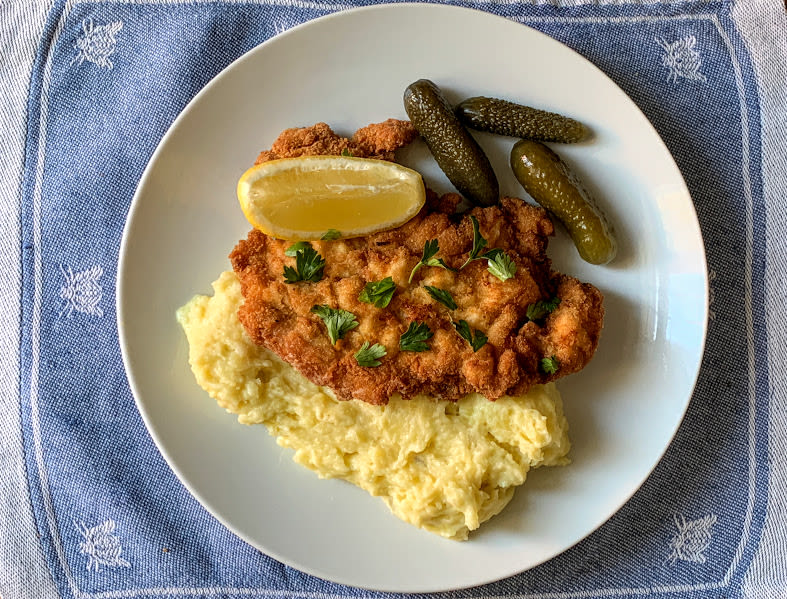
#49 - Schnitzel (rántott hús): This Italian-Austrian breaded veal cutlet has made its way deep into Hungarian kitchens, being a popular dish of Sunday family meals. When done right, a tender and juicy meat hides behind the thin, crispy crust. While the original recipe calls for veal escalopes, Budapest restaurants often serve it with pork loin, chicken breast, or a ham-and-cheese filling (cordon bleu). Recipe.
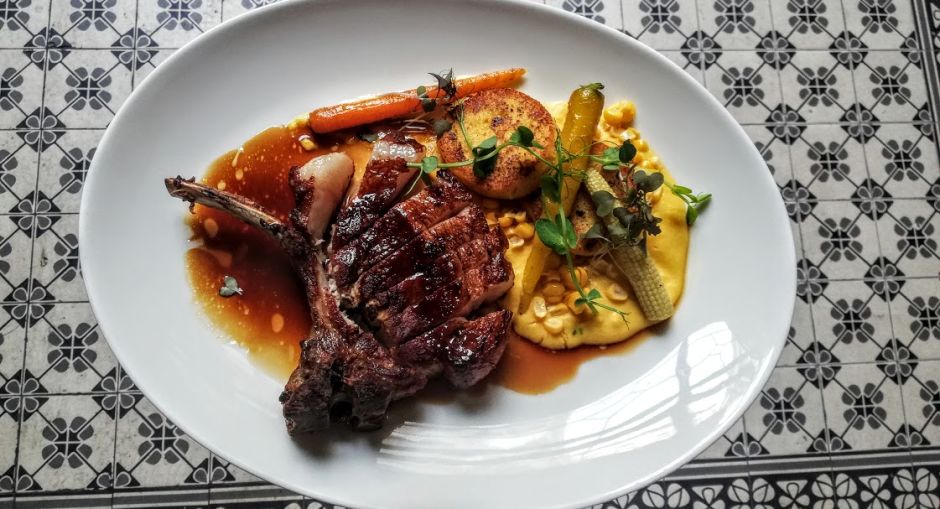
#50 - Mangalica pork chop: Similar to the black-hoofed Iberico, the Hungarian Mangalica is a treasured breed of heritage pig, known for its richly marbled meat and curly "fleece." Michelin-starred restaurants around the world serve Mangalica, but on the home turf in Hungary you'll be able to feast on this porcine delicay at relatively wallet-friendly prices.

#51 - Vadas: Vadas is a catch-all phrase for dishes prepared with an orange-hued, sweet-tart sauce made from pureed root vegetables and spiked with mustard, lemon, and a little sugar. Though originally referred to game meat ("vad" translates to game), restaurants usually serve it with slow-cooked beef (vadas marha). The classic pairing calls for bread dumplings on the side.
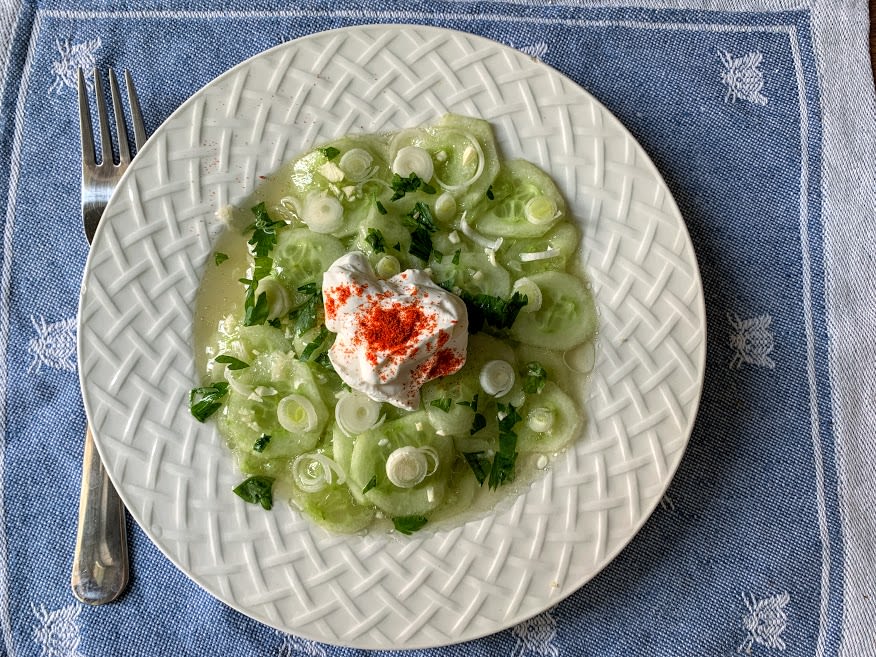
#52 - Cucumber salad (uborkasaláta): As mentioned in the intro, fresh vegetables are usually served as a side dish in Hungary instead of as a separate salad course. Cucumber salad — thinly sliced and spiked with salt, vinegar, sugar, and a blob of sour cream — is especially popular. Your chicken paprikash, goulash, and schnitzel will appreciate a plate of sweet-sour uborkasaláta by their side. Recipe.
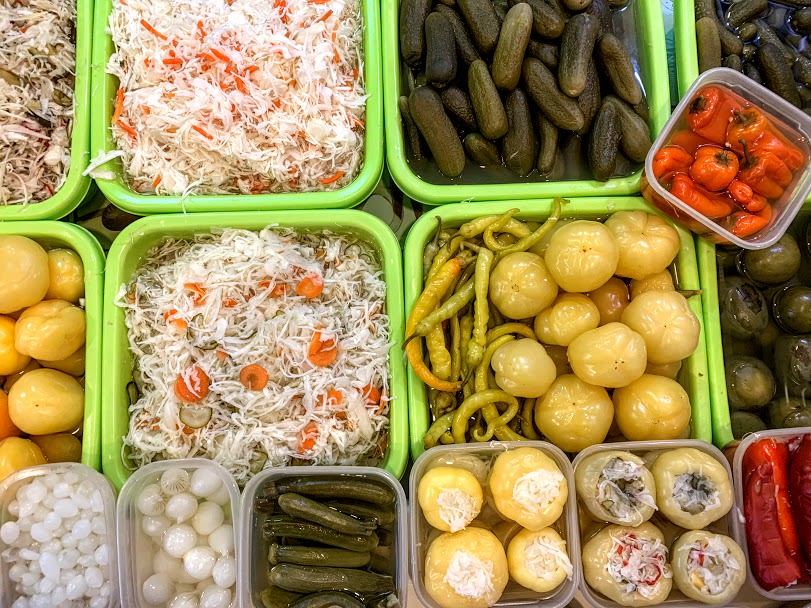
#53 - Pickled vegetables (savanyúság): For a country with a relatively long winter like Hungary, pickled vegetables (savanyúság) provide essential nutrients during the barren months of the year. The savanyúság options are endless: from pickles, to cabbage, to peppers, to beets, to onions, to garlic, to you-name-it. Most savanyúság is made in a vinegar brine spiked with sugar to balance out the acidity, except for pickles and sauerkraut, which are usually fermented.
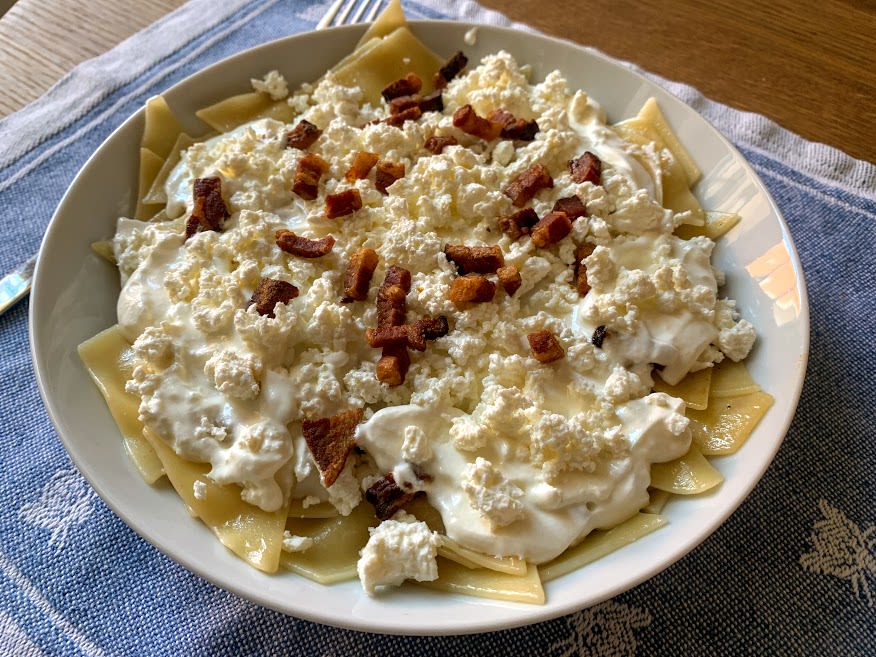
#54 - Cottage cheese noodles (túrós csusza): A late-medieval Hungarian dish that has remained well-liked ever since. Túrós csusza consists of slippery egg noodles smothered in sour cream and túró and sprinkled with crispy pork cracklings. The preparation is very simple, the key here is having good ingredients and using them with a generous hand. Hungarians often eat it as a second course after a fisherman's soup. Recipe.
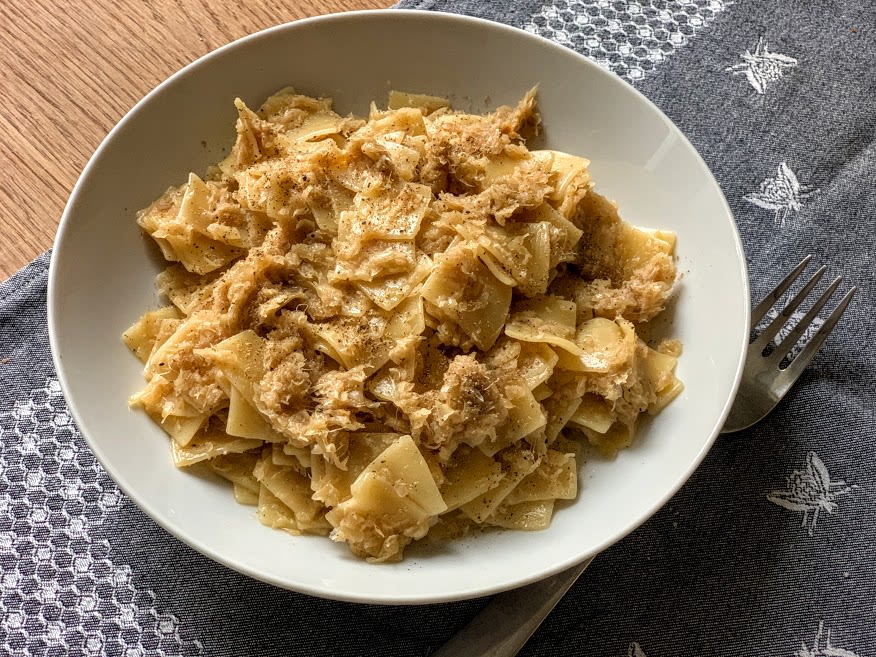
#55 - Cabbage noodles (káposztás tészta/cvekedli/kocka): Hungarians have been eating both cabbage and noodles for hundreds of years, so it’s no surprise that the two appear together in this dish. The shredded and roasted cabbage coats every inch of the square-shaped bits of slippery pasta. A bit of sugar adds sweetness, and a generous seasoning of freshly ground peppers lends the dish its signature pungent flavor. Recipe.
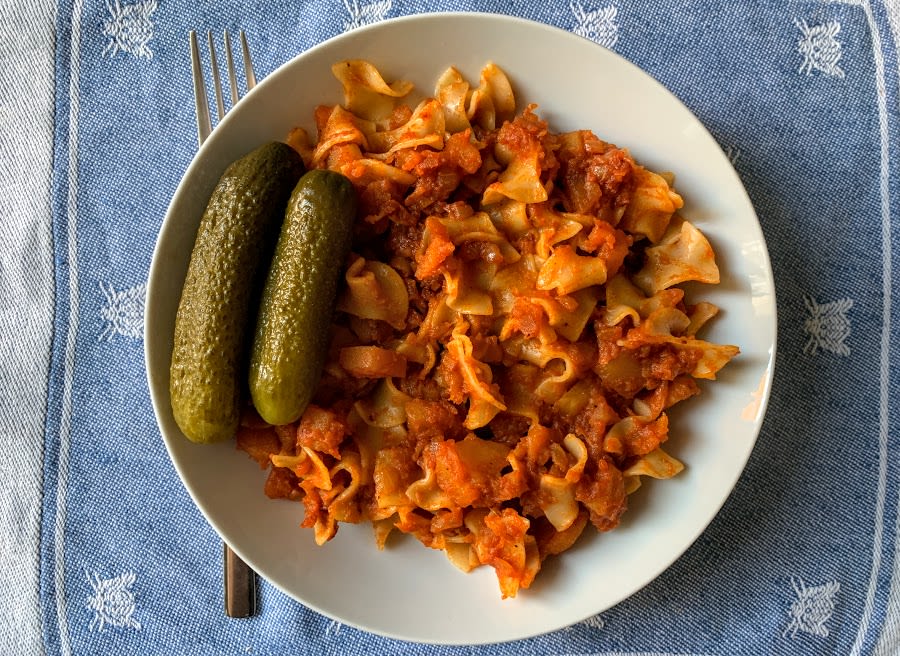
#56 - Potato noodles (gránátoskocka / krumplis tészta): Who knew that potatoes with noodles can be so gratifying? For prudence, you may want to save this one for a day when physical exercise helps offset the double-dose of carbs before you. The apocryphal story is that the dish harks back to the Napoleonic Wars, when all that the Habsburg military could serve its soldiers were noodles and potatoes, which the resourceful Hungarians jazzed up in the usual way: with onions and paprika. Recipe.
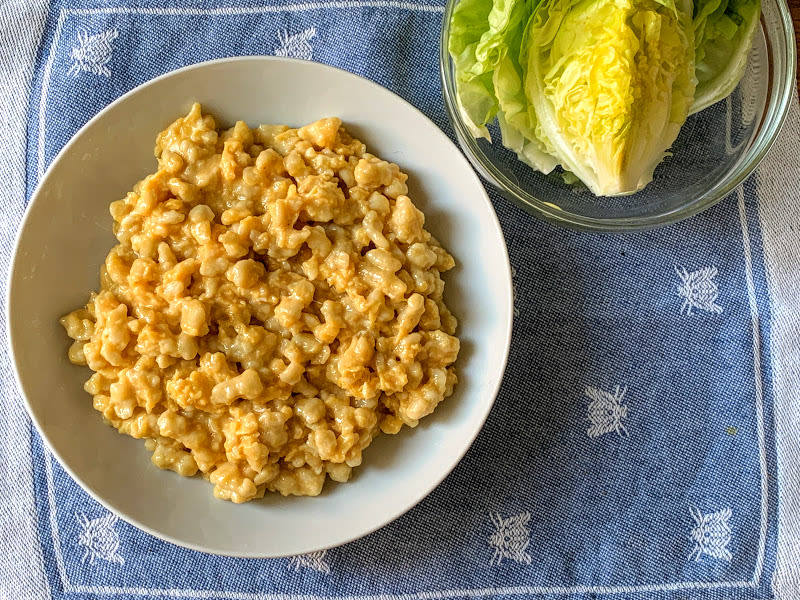
#57 - Egg dumplings (tojásos nokedli / galuska): The tojásos nokedli is proof that spätzle-like dumplings can play more than just a supporting role on a plate. Using a strainer board, all you need to do is shave coarse bits of runny dough into a pot of simmering water (scoop them out when they appear on the surface a few minutes later). The key to this dish is the creamy scrambled eggs folded into and glued to the dumplings. As well as a side of fresh, sweet-sour lettuce. Recipe.
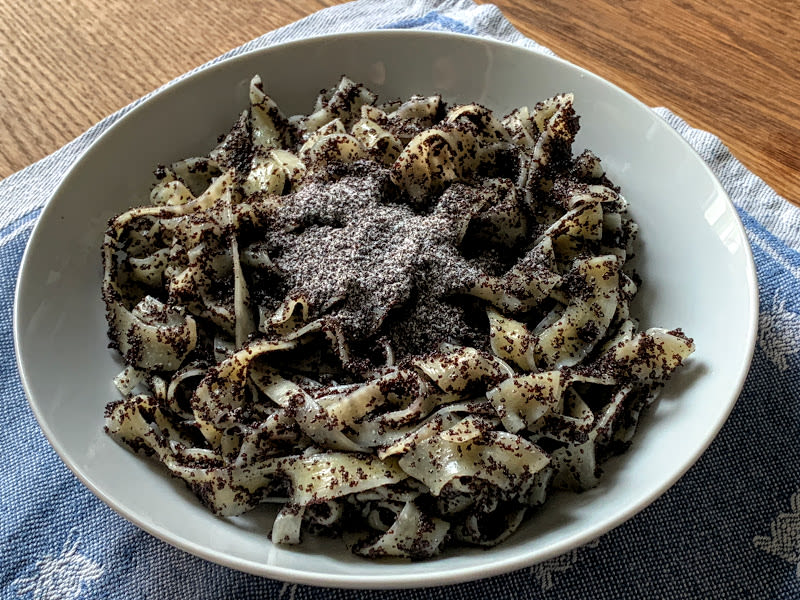
#58 - Poppy-seeds noodles (mákos tészta): Recipe collections from the 16th century already include this easy-to-whip-up noodle dish blanketed in ground poppy seeds and powdered sugar, which Hungarians used to eat on days of abstinence. Thanks to the trace amounts of opiates, exasperated parents would also serve this to soothe their unruly children and help them fall asleep. Recipe.
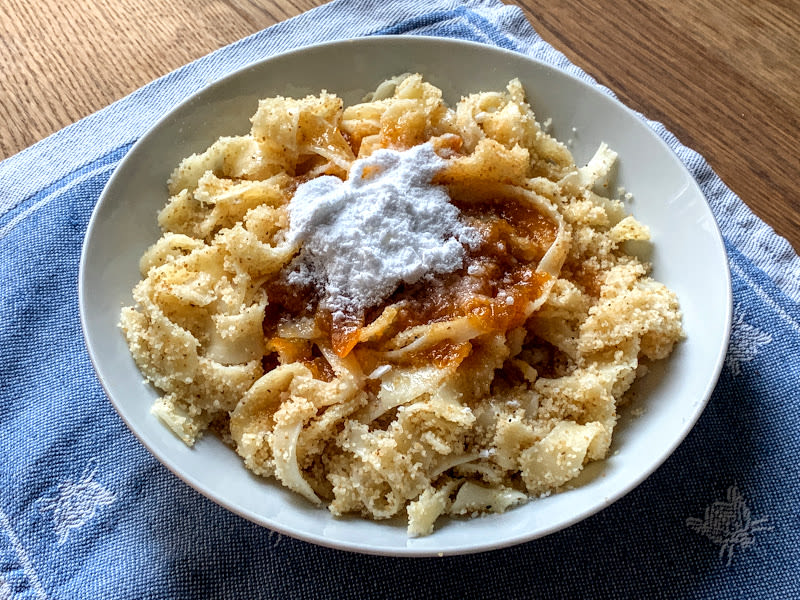
#59 - Semolina noodles (grízes/darás tészta): Another unfancy but inventive sweet noodle dish, the grízes tészta is generously layered with toasted and soaked semolina. What helps win over the hearts of people about this one is the generous dollop of runny apricot jam topping. Recipe.
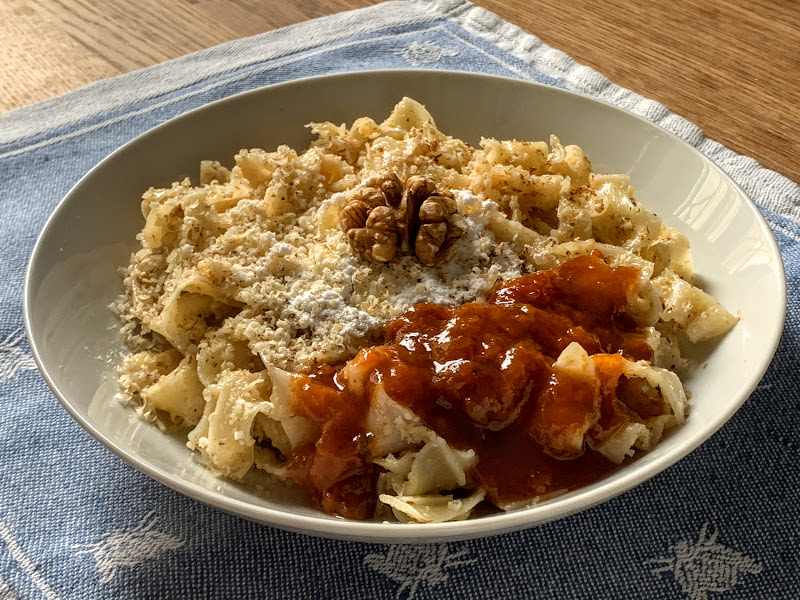
#60 - Walnut noodles (diós tészta): Yet another member of the weird and wonderful group of sweet pasta dishes in Hungary. The egg noodles are first slicked with butter, then showered in ground walnuts, powdered sugar, and runny fruit preserves. Simple and delicious. Recipe.

#61 - Cottage cheese dumplings (túrógombóc): Túrógombóc combines Hungary’s fondness for túró, a fresh curd cheese appearing in many dishes, and the Czech and German preference for knödels/dumplings. It’s one of those foods that amount to more than the sum of their parts, especially when kept light with only a minimal amount of flour or semolina. The sour cream and powdered sugar toppings drive home the signature sweet-tart flavor of the dumplings. Recipe.
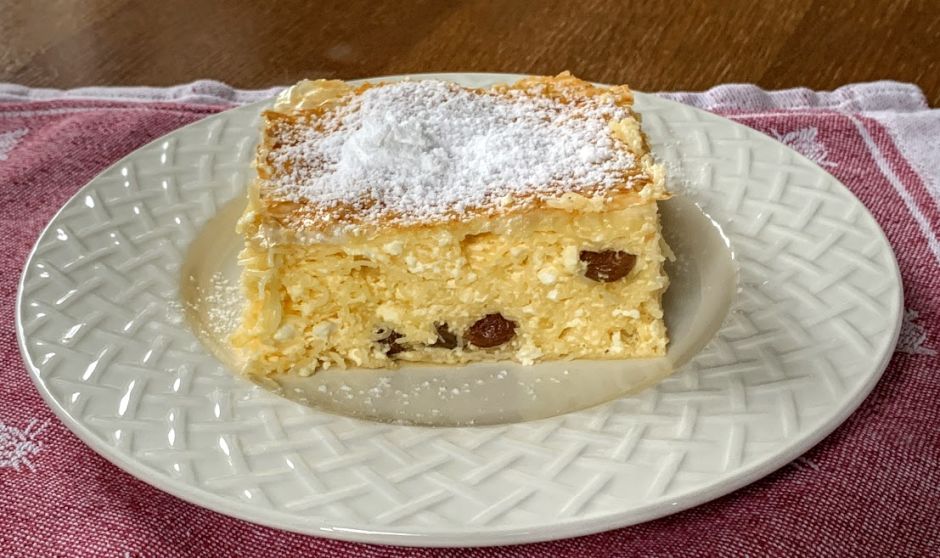
#62 - Vargabéles: This rich dessert treat harks back to the Transylvania of the 1930s, where it was one of the signature offerings of Darvas restaurant in the city of Cluj (Kolozsvár). The dish became so renowned that Budapest-based Gundel restaurant would order same-day deliveries by air. The strudel-cake encloses fresh túró (cottage cheese) layered with thin noodles and a sweet and light and raisins-laced cream. Restaurants usually serve a generously portioned slice as a second course after soup. Recipe.
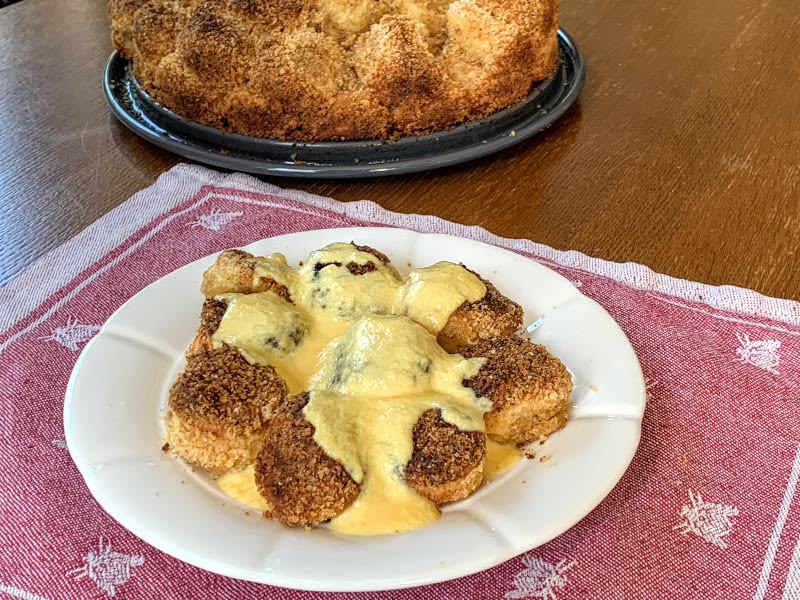
#63 - Yeast rolls (aranygaluska): Sweet yeast rolls are common across Central Europe; in Hungary, they usually appear as these feather-light buns coated in melted butter and ground walnuts and baked to a golden brown. Aranygaluska is impossible to stop eating, especially if you drown each bit in vanilla custard. Recipe.

#64 - Kaiserschmarrn (császármorzsa): This shredded pancake sprinkled with powdered sugar and raisins is another adored dessert across the former Austria-Hungary (the American novelist F. Scott Fitzgerald called the dish simply "formidable"). Some say it's named after “the Kaiser,” Habsburg emperor Franz Joseph, but more likely is that it originated among Alpine herdsmen ("Kaser"). In Hungary, people make it with semolina instead of regular wheat flour and bathe the plate in runny fruit preserves. Recipe.
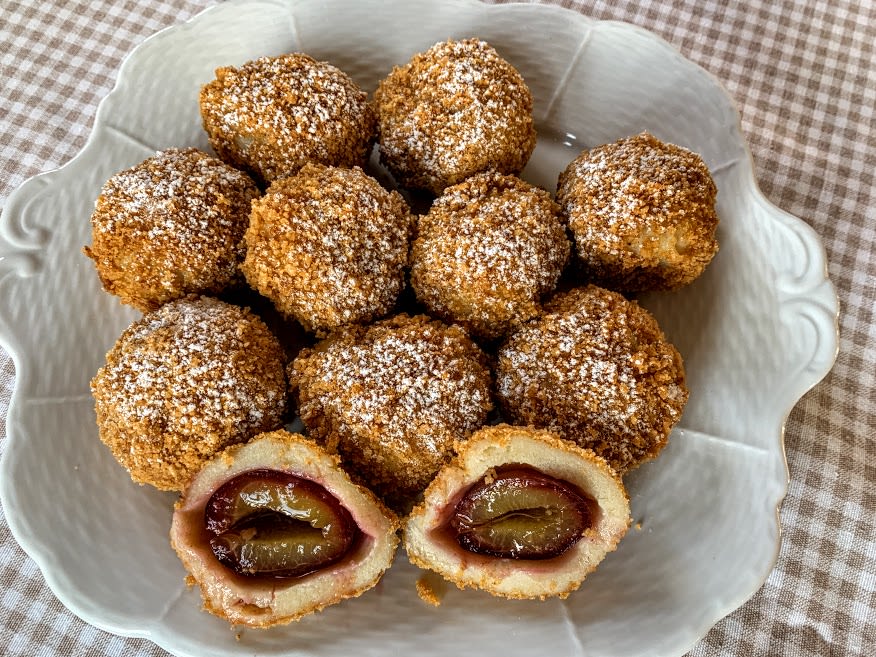
#65 - Plum dumplings (szilvás gombóc): When George Lang, the legendary Hungarian-American restaurateur, was asked what his last meal would be, plum dumplings were one of the dishes he picked. These light, potato-dough dumplings, which originate in Austria-Hungary, are especially rewarding in the early fall when plums are at the height of the season. Recipe.
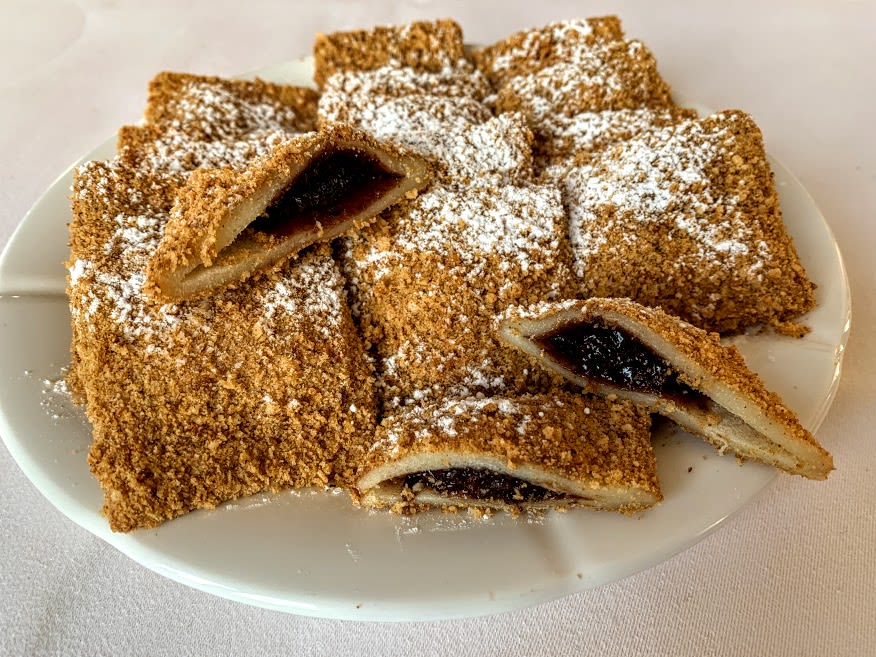
#66 - Jam-filled dumplings (derelye / barátfüle): A filling of plum jam (szilvalekvár) or sweet cottage cheese (túró) can really crank up these ravioli-like dessert dumplings, which are rolled in breadcrumbs and sprinkled with powdered sugar. People often make derelye with potato dough as a byproduct of the plum dumplings, above.
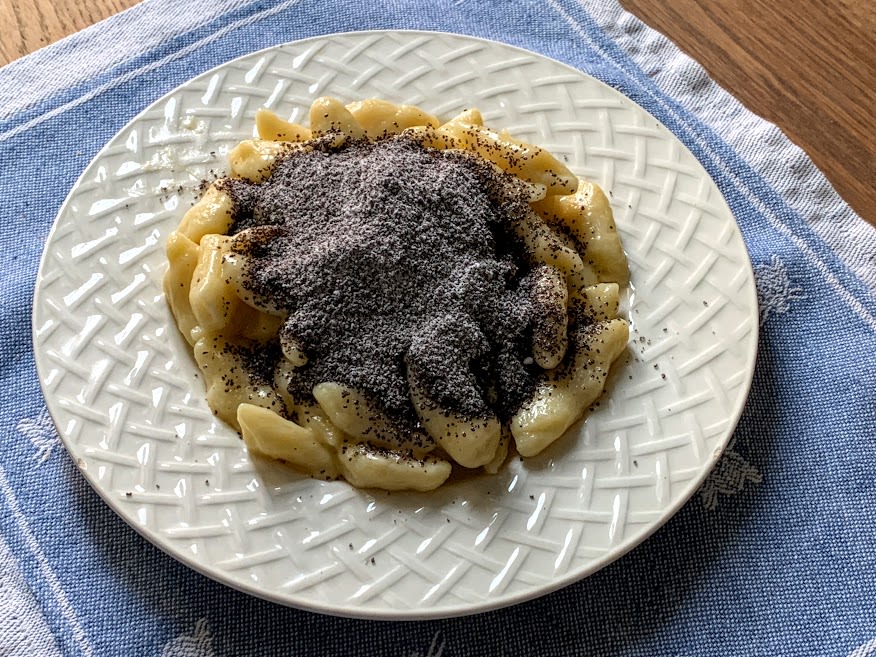
#67 - Poppy-seeds dumplings (mákos nudli): Yes, potato dumplings are endlessly versatile. Instead of a filling, these diamond-shaped gnocchi are coated in butter and sugared poppy seeds (or ground walnuts). As with its two sister dishes, above, people usually eat mákos nudli as a main course after a hefy soup. Recipe.
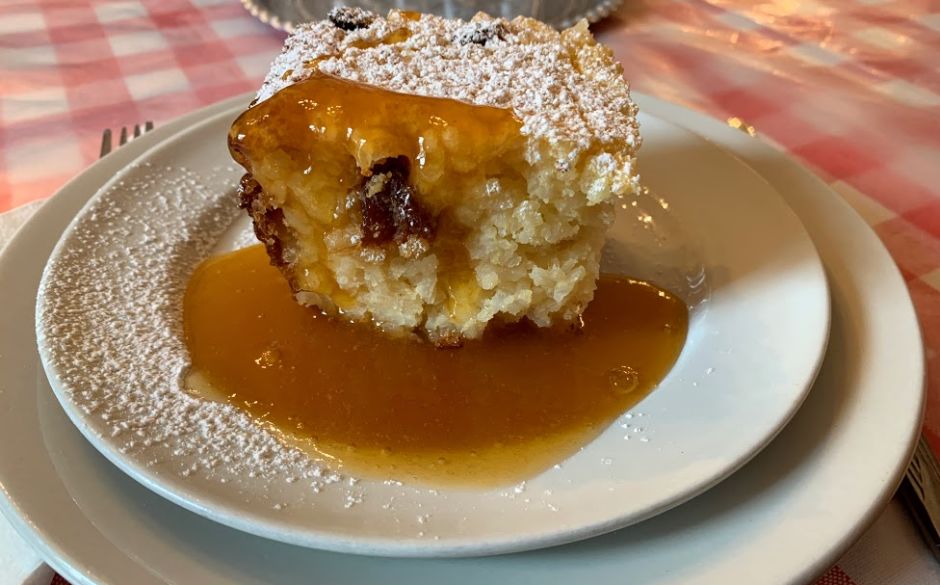
#68 - Rice pudding souffle (rizsfelfújt / rízskoch): A staple in canteens and cafeterias across Hungary, this rice pudding souffle is dotted with raisins, flavored with lemon zest, and baked to a golden brown. People usually finish it with powdered sugar and peach preserves.
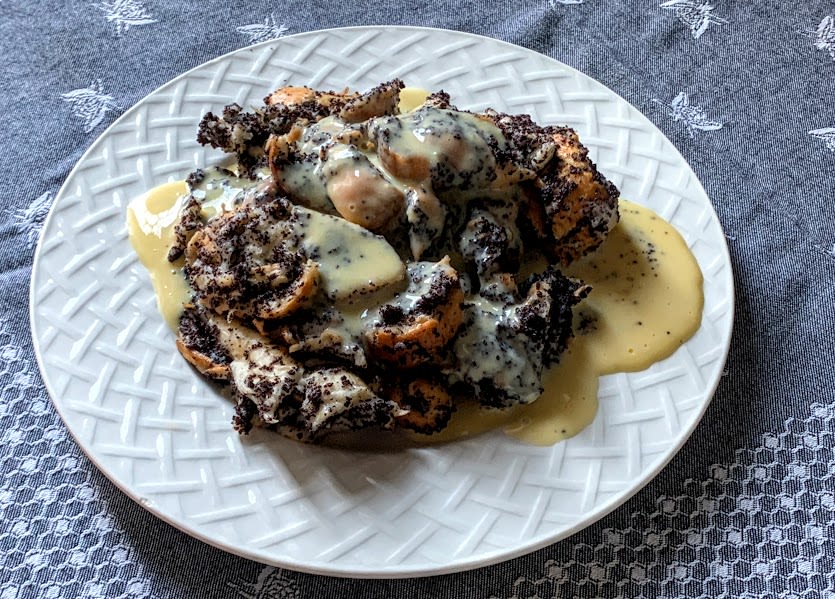
#69 - Poppy seeds bread pudding (mákos guba / bobajka): It’s hard to think of a more rewarding depository for leftover, stale bread rolls than this classic bread pudding which was featured in recipe collections as early as the 17th century. Bolstered with scalded sugary milk and finely ground poppy seeds and finished with a creamy vanilla sauce, the tired bread chunks transform into a moist, deeply satisfying dessert dish. Recipe.

#70 - Máglyarakás: As with the mákos guba, above, the máglyarakás is a wonderful transfiguration of stale bread into a rich dessert dish. Here, layers of rum-laced apples, raisins, and fruit preserves bolster the milk-soaked base, and the bonus is the soft meringue on top. The Austrian Kipferlschmarren is very similar to it. Recipe.
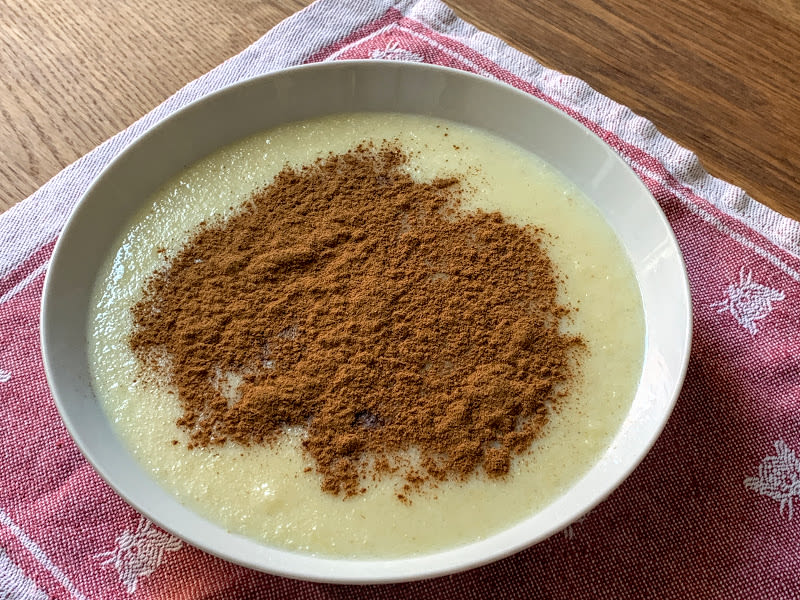
#71 - Semolina porridge (tejbegríz): For many Hungarian people, a plate of semolina cooked in sugary milk is the quintessential comfort food, evoking fond childhood memories. Growing up, I used to eat it at least once a week, sprinkled with cocoa powder, cinnamon sugar, or runny fruit preserves. In the 16th and 17th centuries, tejbegríz also appeared on the dining tables of the aristocracy, who lavishly spiked it with saffron for a deep-yellow color and added aroma. Recipe.
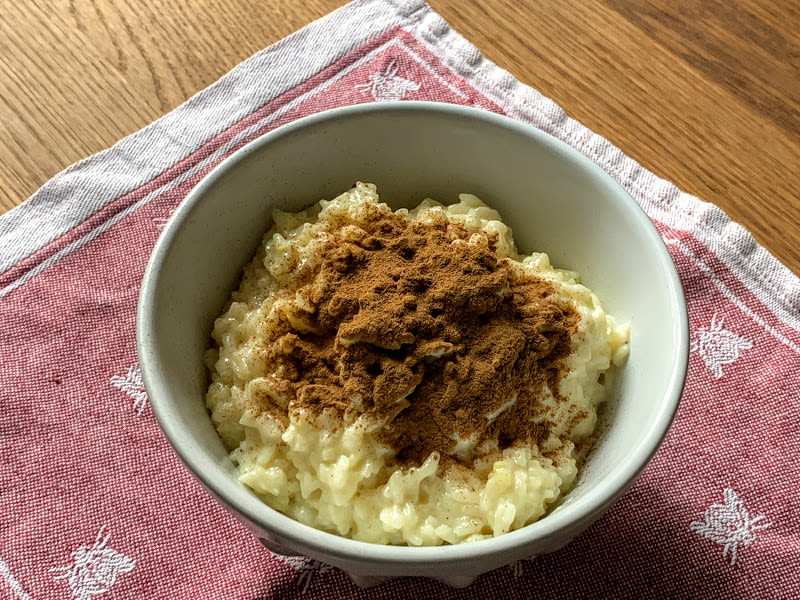
#72 - Rice porridge (tejberízs): As elsewhere in Europe, imported rice was regarded for a long time as a luxury ingredient in Hungary and reserved for special occasions. Until the 19th century, wedding receptions often ended with a serving of rice porridge cooked in sugary milk and boosted with ginger. Today, similar to the semolina porridge, tejberízs is mainly a comfort food and especially popular among children. Recipe.
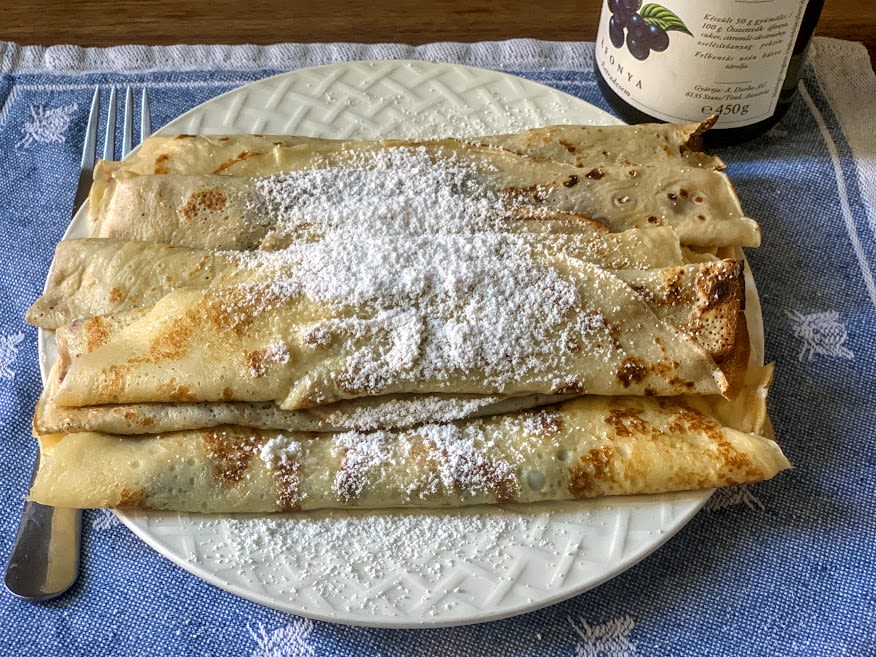
#73 - Hungarian crepes (palacsinta): No doubt, the number one dessert food in Hungary is palacsinta, wonderfully thin, unyeasted pancakes. They're usually rolled with fruit jam, sugary cottage cheese (túró), cinnamon-sugar, or sweetened lemon juice, but savory stuffings also exist, most famously in the veal-stew filled Hortobágyi palacsinta. Palacsinta is easy to whip up so nothing should stop you from giving it a try at home. Recipe.
My content is free and independent. If you've enjoyed this article, please consider supporting me by making a one-time payment (PayPal, Venmo).
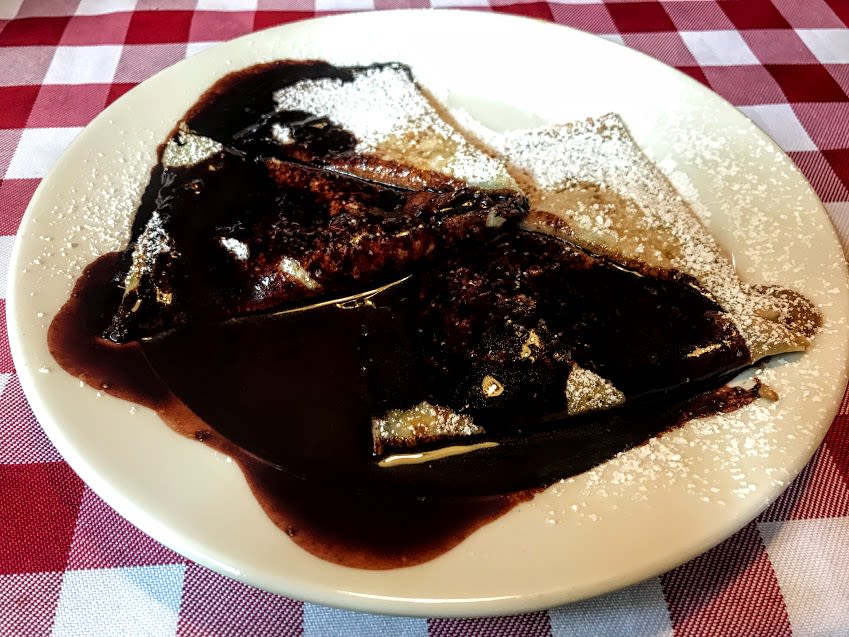
#74 - Gundel palacsinta: This gussied-up fried palacsinta bathed in chocolate cream has a filling of rum-laced ground walnuts with candied orange and raisins. There are various origin stories, but most likely it was Ilona Matzner, wife of the celebrated Hungarian writer Sándor Márai, who introduced this pancake to Károly Gundel, who later perfected it at his renowned Budapest restaurant.

#75 - Pogácsa: These soft snacks are among the most traditional — dating back to medieval Hungary — and widespread across the country. They come in different sizes and varieties: you'll find pogácsa dotted with pork cracklings (töpörtyűs), filled with cottage cheese (túrós), and topped with melted cheese (sajtos). Both bakeries and pastry shops sell pogácsa, but those often can’t hold a candle to a fresh homemade version.
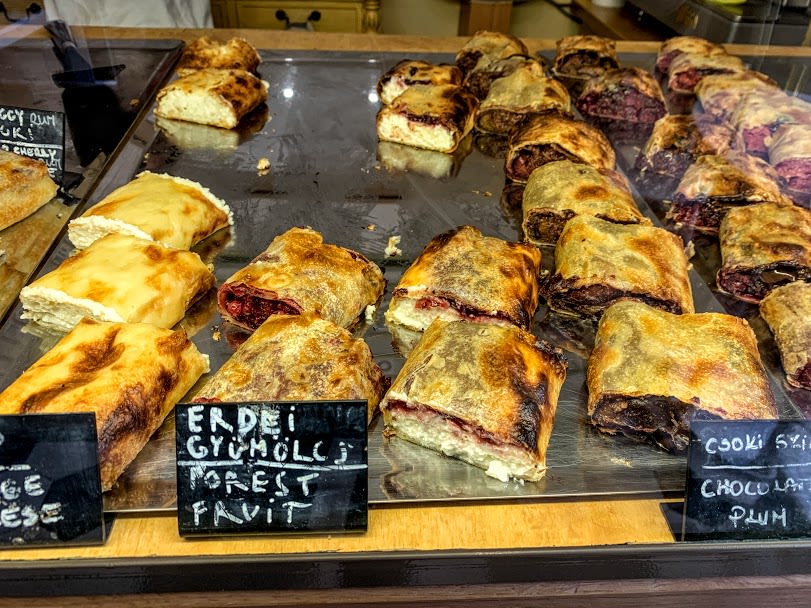
#76 - Strudel (rétes): Strudels evolved from the baklava, which Hungarians took from Ottoman Turkey when it ruled the country in the 16-17th centuries. Later, strudels spread across the whole Austro Hungarian Empire. What makes them unique in Hungary is the sheer variety of fillings, both sweet and savory. Have you had more than enough apple strudels in Vienna? No problem, try one with cottage cheese (túró), cabbage, or poppy seeds in Budapest. My favorite in Budapest: Strudel House and Strudel Hugó.

#77 - Bejgli: During Christmas, no Hungarian dining table is complete without these sweet rolls filled with finely ground poppy seeds and walnuts. People usually place them on a plate side by side because there's a folk belief that the poppy seeds bring prosperity and the walnuts keep trouble away. Bejgli is a staple across countries in Central Europe.
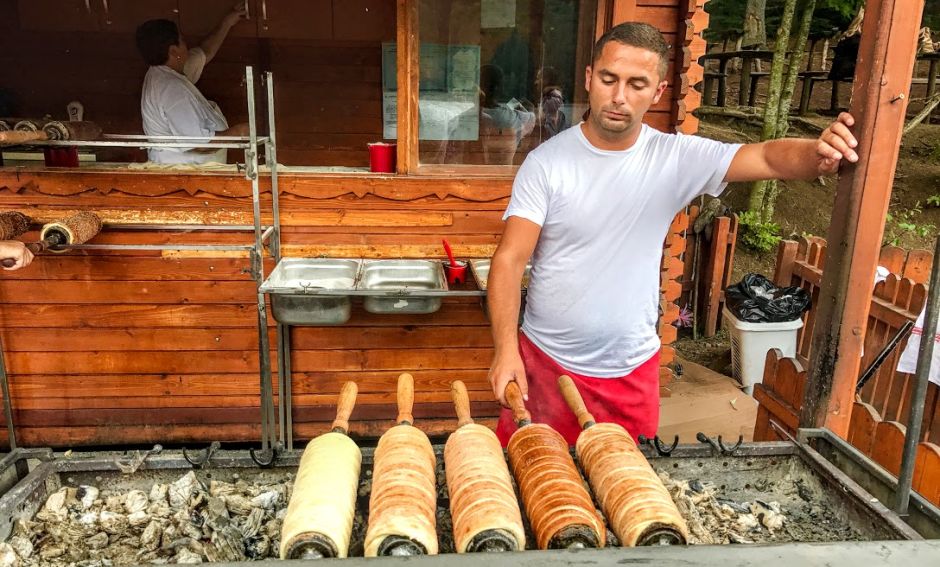
#78 - Chimney cake (kürtőskalács): Feel free to just tear into this aromatic Transylvanian chimney cake flaunting a caramelized crust and a chewy, soft interior. Kürtőskalács is prepared by wrapping a long strip dough around a baking spit and then cooking it over charcoal (as seen above). Traditionally, people made it for family celebrations. My favorite in Budapest: plenty of kürtőskalács vendors exist in Budapest's downtown, for example Molnár's, but only Vitéz Kürtős by the Budapest Zoo makes them over charcoal.
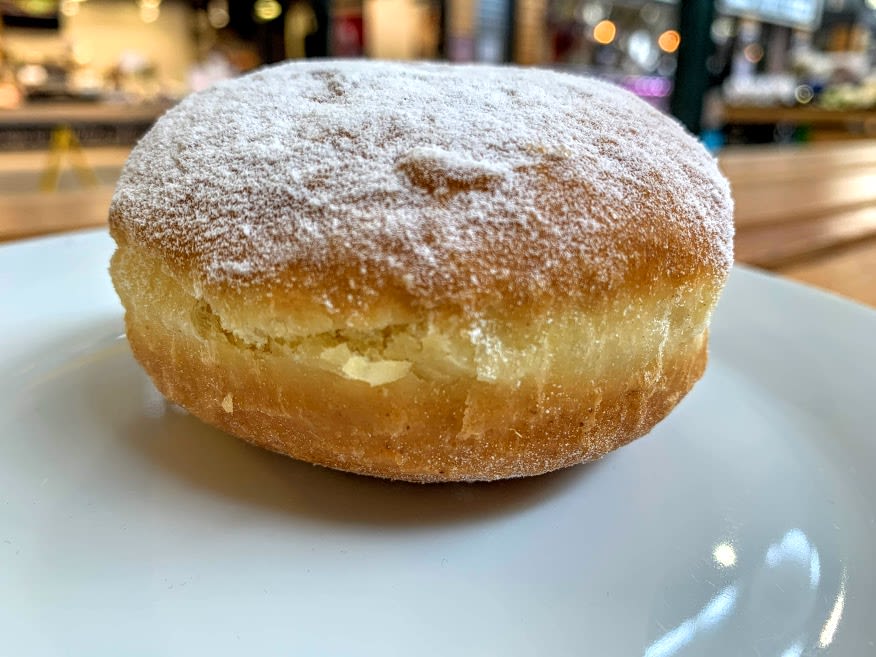
#79 - Doughnut (fánk): You might know it as krapfen, Berliner, bombolone, sufganiyah, or jelly doughnut — fánk is the Hungarian version of this centuries-old deep-fried pastry traditionally eaten in the days of Carnival. These days, most bakeries and grocery stores in Hungary serve them year-round and the fánks usually come with a filling of fruit jam or vanilla custard.
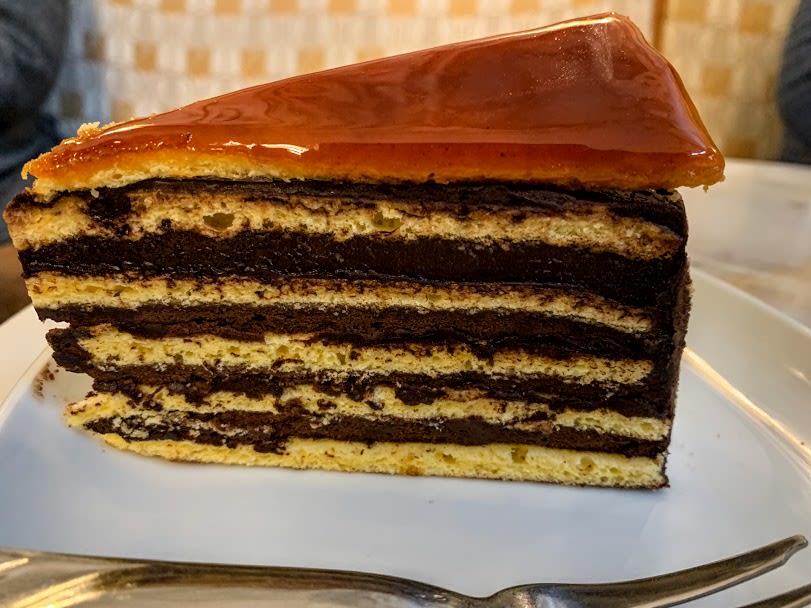
#80 - Dobos torte: It was confectioner József C. Dobos who created in the 1880s this famous sponge cake layered with chocolate butter cream. The Dobos torte's signature feature is the shiny, brittle caramel topping. After pathetic attempts by competitors to replicate his concoction, Dobos made the recipe public and, still today, you'll find Dobos torte in most Budapest pastry shops. Here you can read about other classic Hungarian cakes and pastries. My favorite in Budapest: Auguszt Buda.
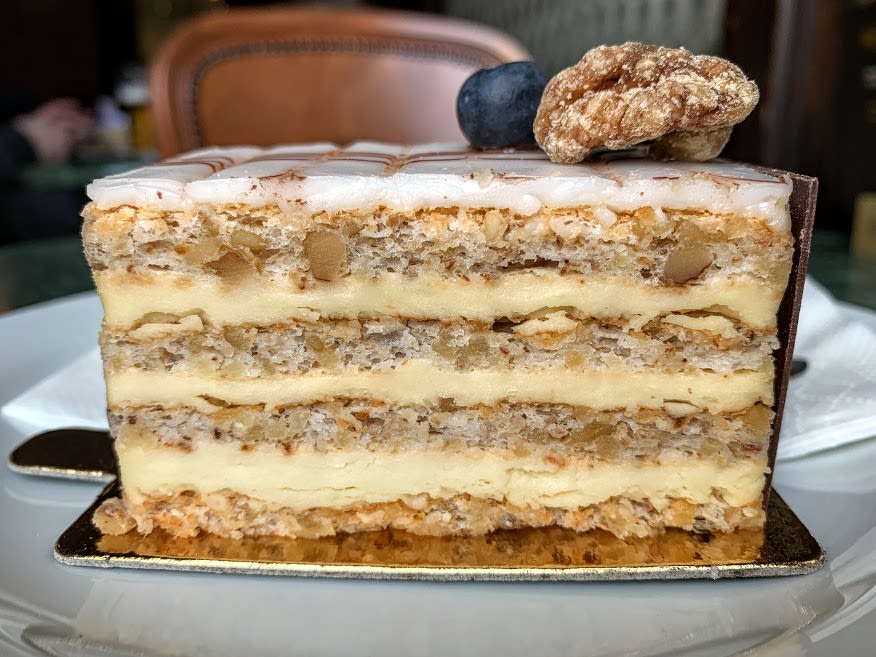
#81 - Esterházy torte: Named after a Hungarian royal dynasty, the Esterházy torte is one of the most well-known in and outside the country. It comprises alternating layers of ground walnuts (or almonds) and rum-laced buttercream with a white fondant coating. Interestingly, the cake contains no flour. At its best, the Esterházy torte is rich, but not cloying.
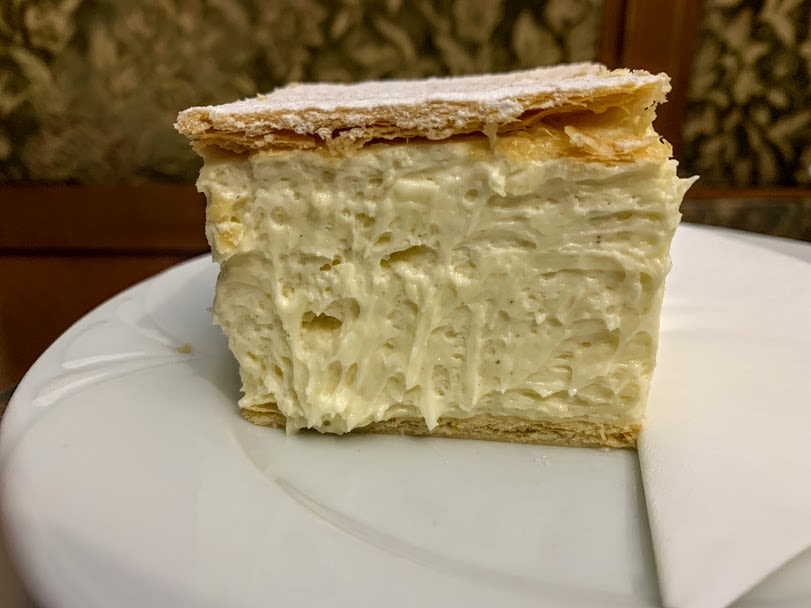
#82 - Krémes: Similar to a Napolean pastry, krémes is a cherished custard slice across Central Europe with each country flaunting a slightly different version. In Hungary, apart from regular krémes — vanilla custard enclosed by puff pastry — there's also "francia krémes," which comes with an extra layer of whipped cream and a caramel glaze on top. My favorite in Budapest: Ruszwurm.

#83 - Flódni: This rich cake layered with plum jam, apple, ground walnuts, and ground poppy seeds originates in Hungary's Jewish community. Traditionally, people ate it for the Jewish holiday of Purim, but today flódni is a cherished treat and widely available across Budapest pastry shops. (I wrote an article about the current flódni renaissance in Budapest.) Recipe.
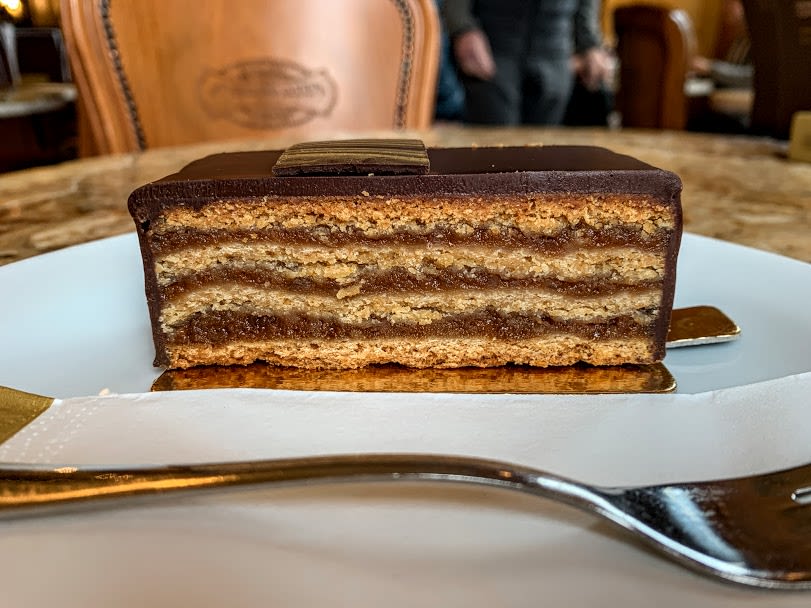
#84 - Gerbeaud slice: Created at the historic Café Gerbeaud, this bite-sized cake is a staple of all pastry shops in Hungary. Under a chocolate glaze lie layers of a sweet dough alternating with a filling of ground walnuts and apricot jam.

#85 - Somlói galuska: Despite being a relatively recent invention, dating back to the 1950s, the somlói galuska is a beloved dessert dish across Hungary. It consists of a rum-infused sponge cake soaked in vanilla custard, chocolate cream, and whipped cream, with a sprinkling of walnuts and raisins. Apart from pastry shops, restaurants also serve it. My favorite in Budapest: At these pastry shops.